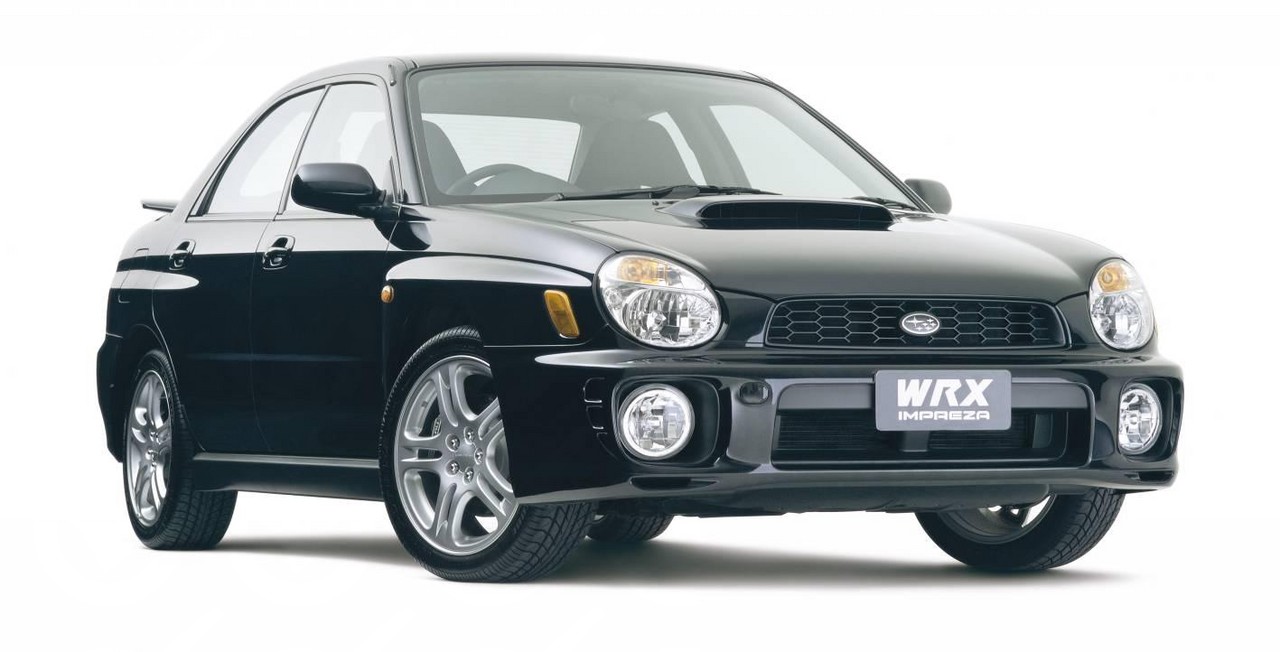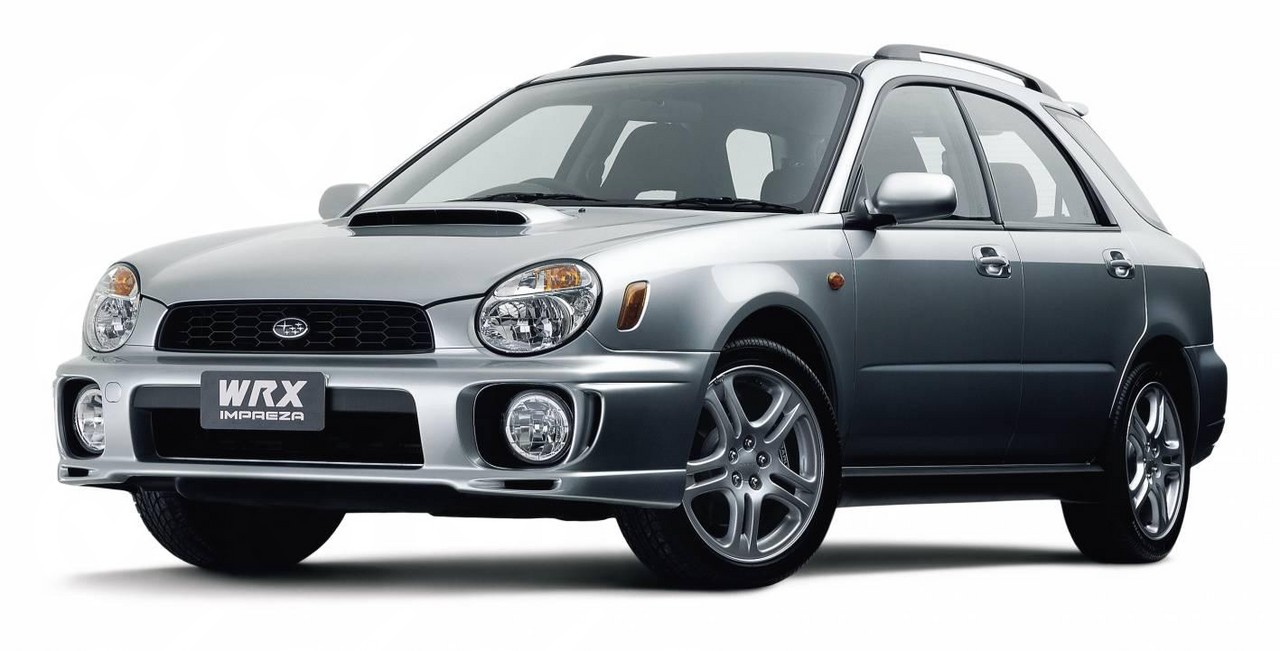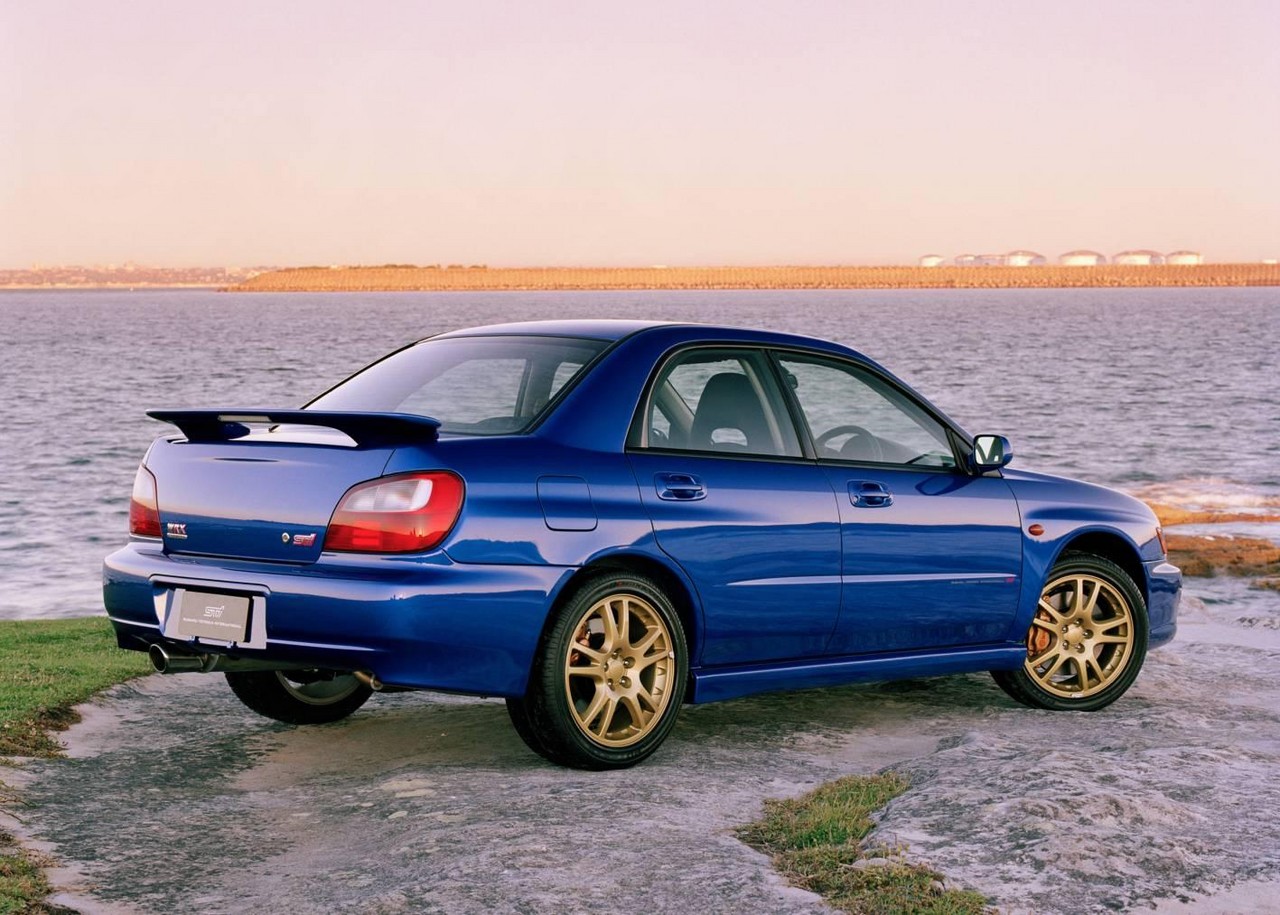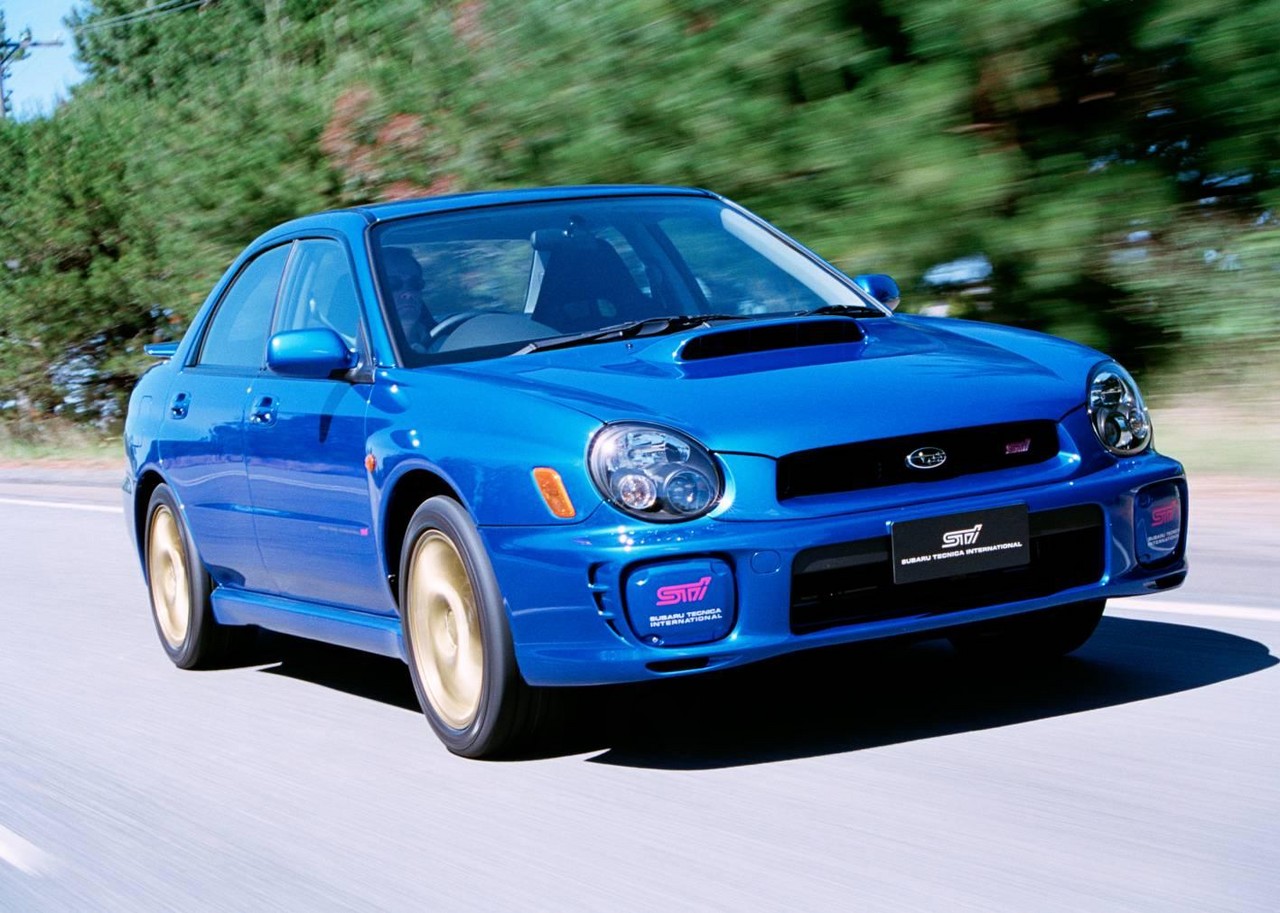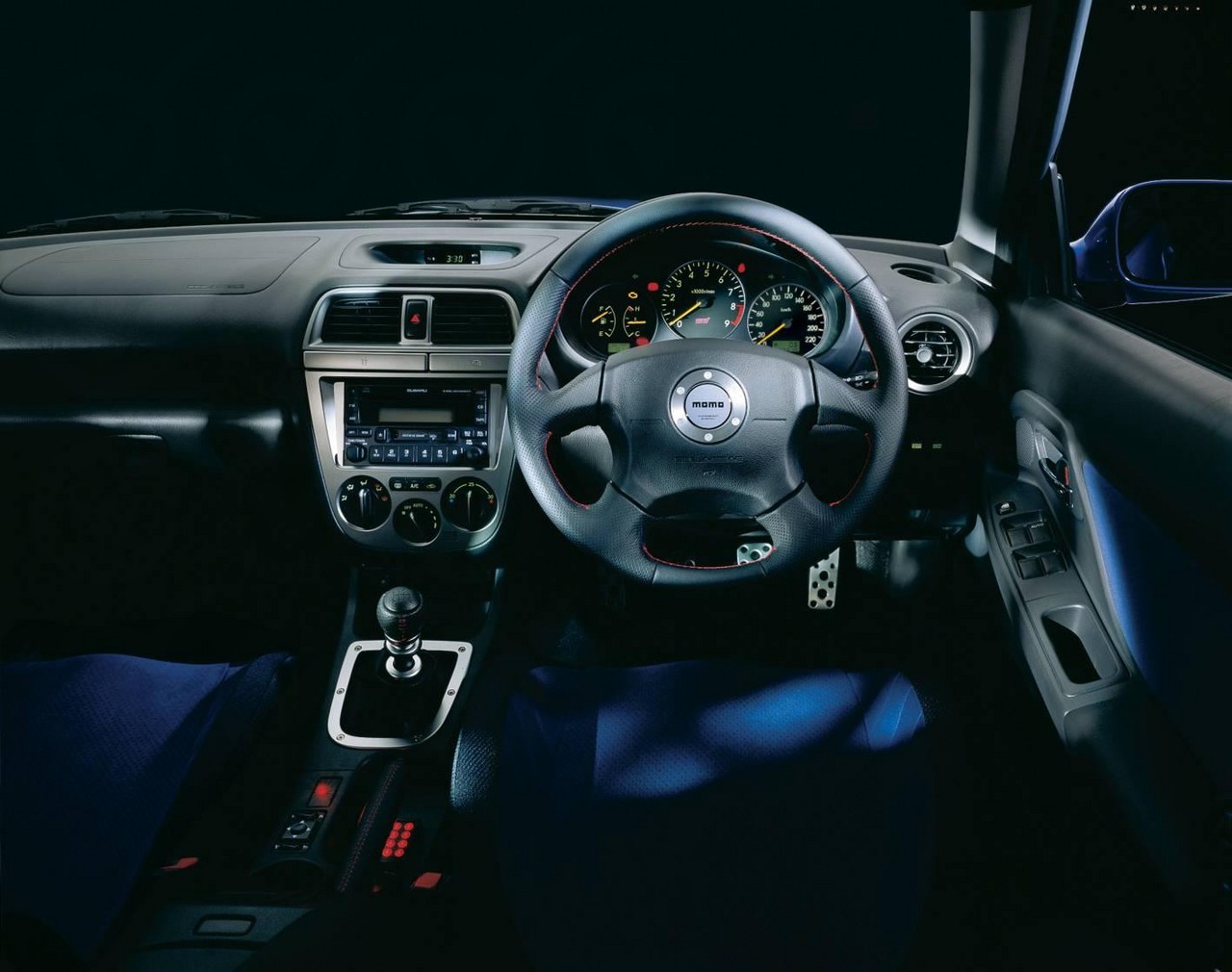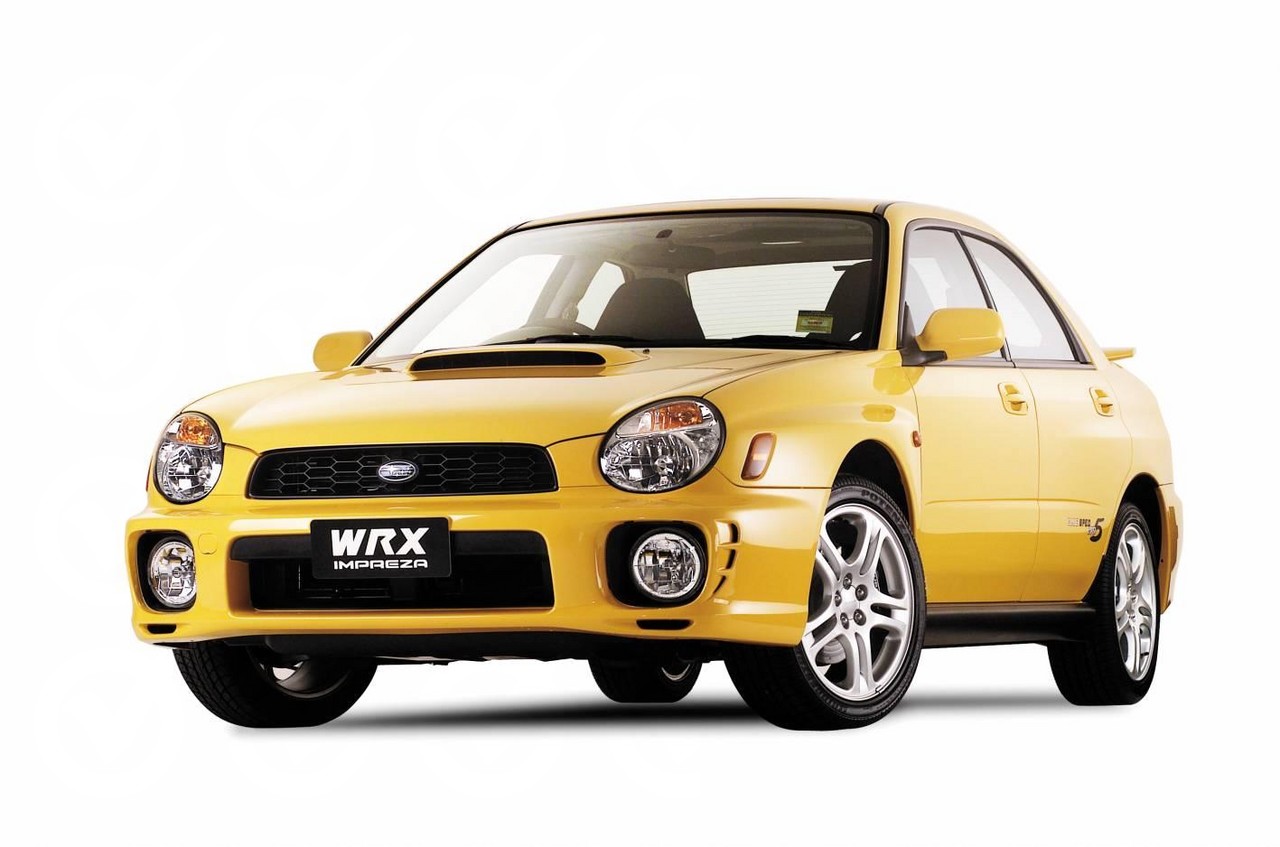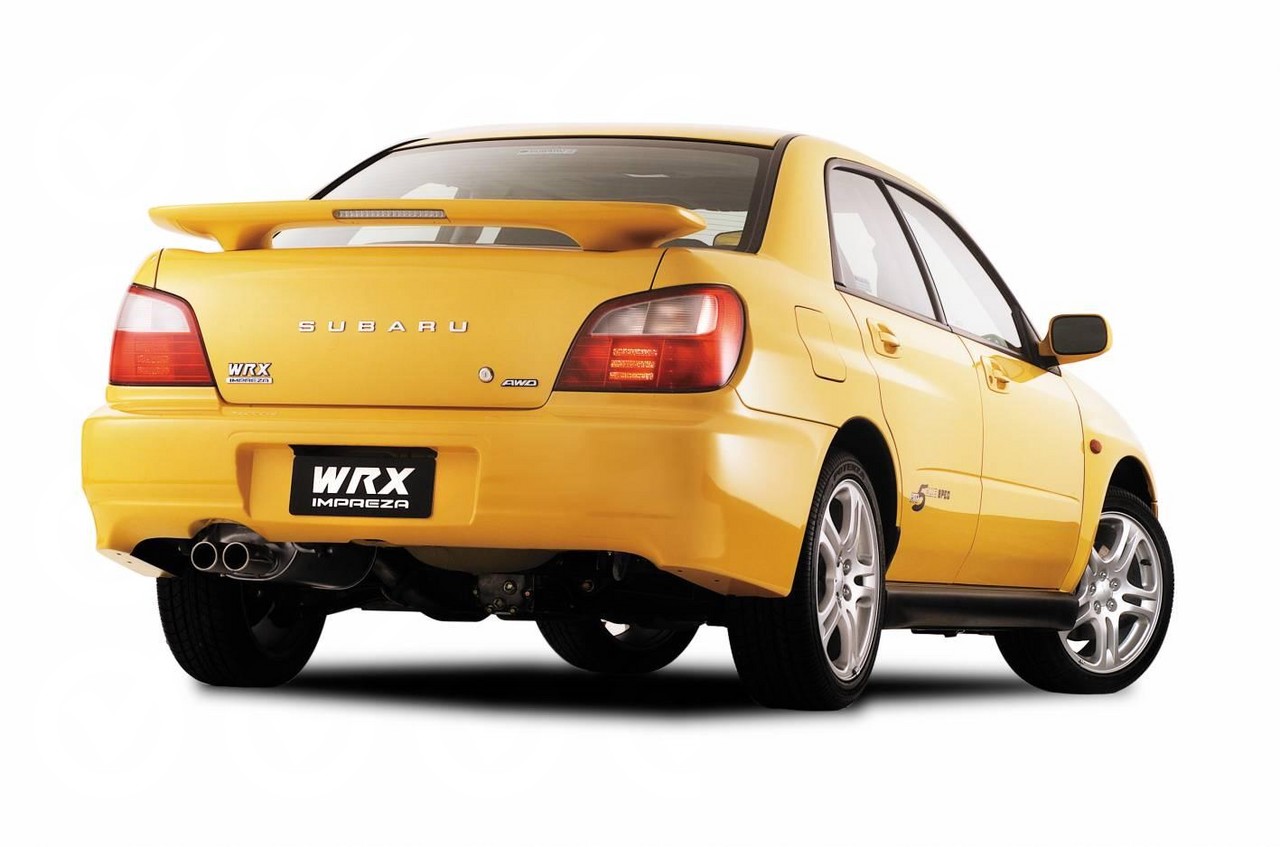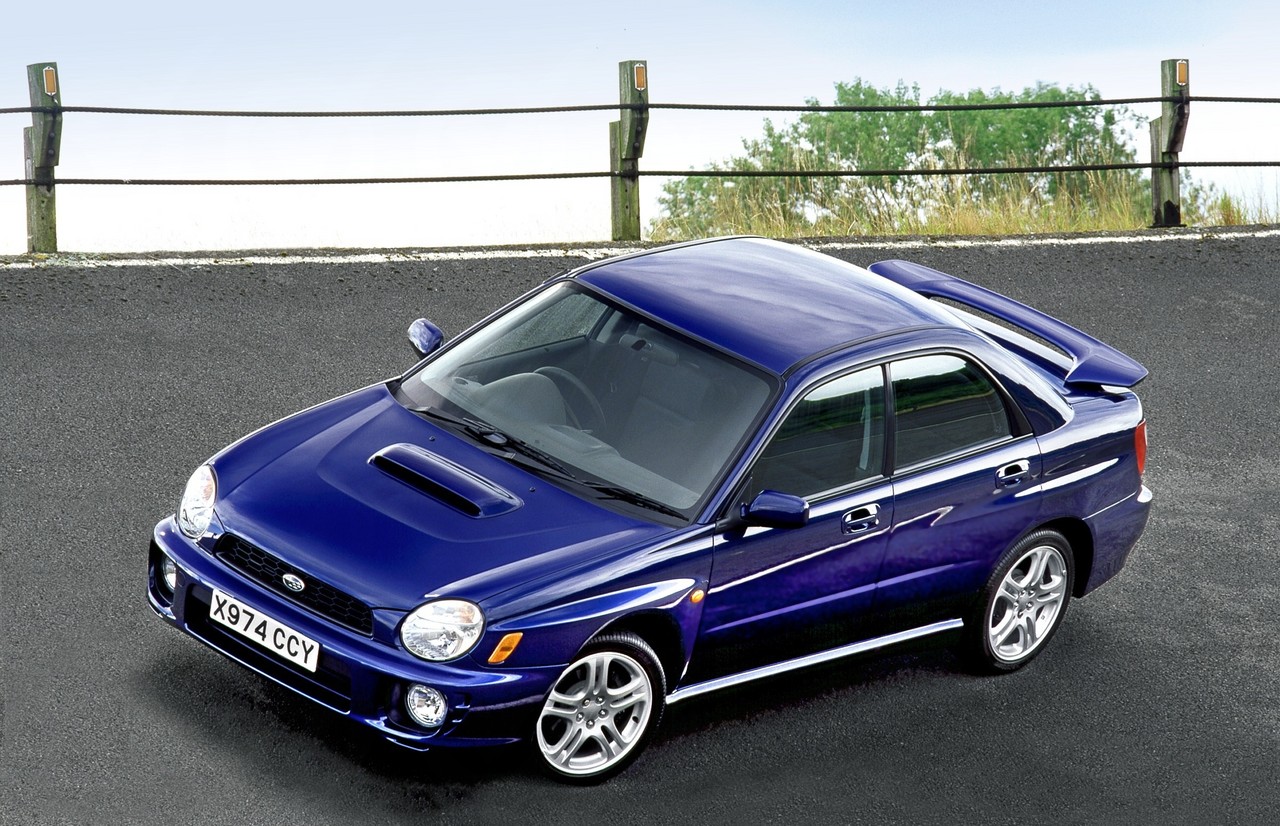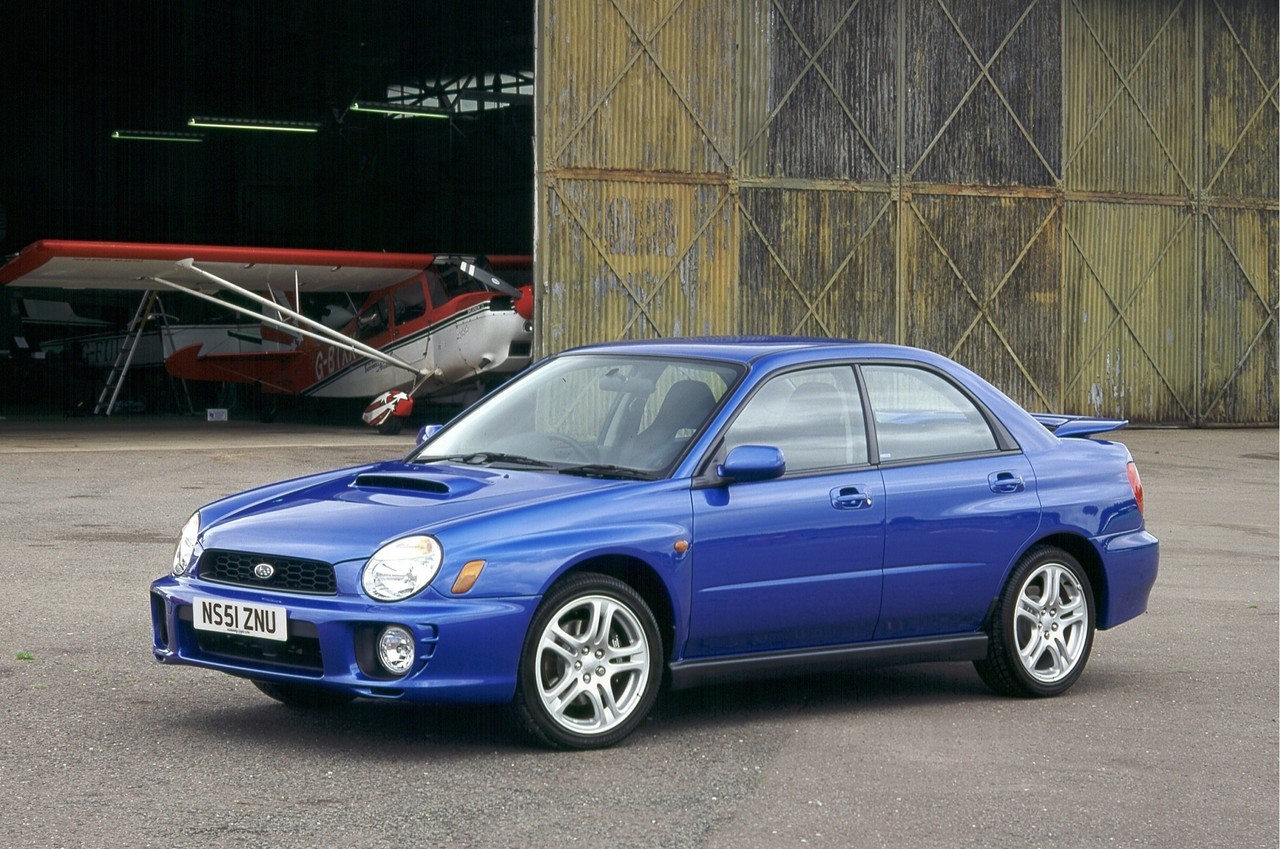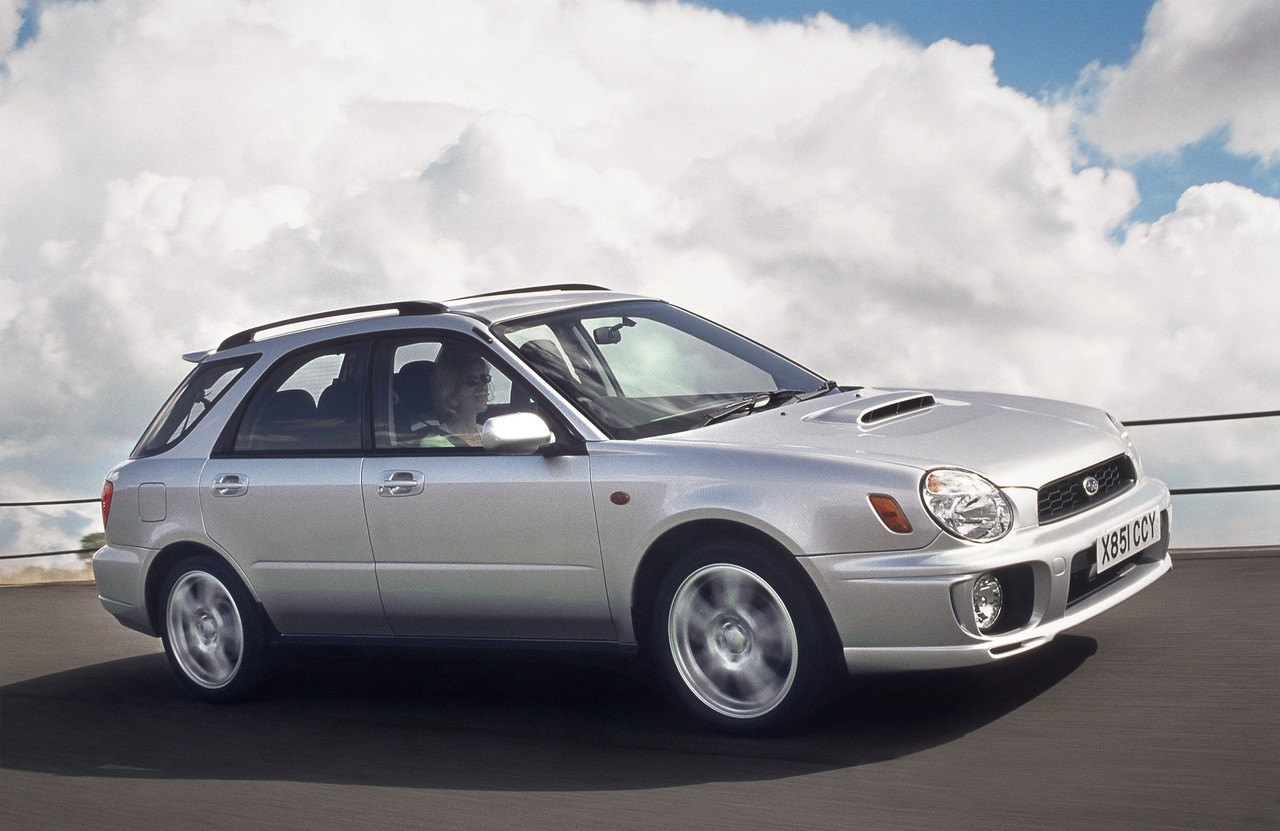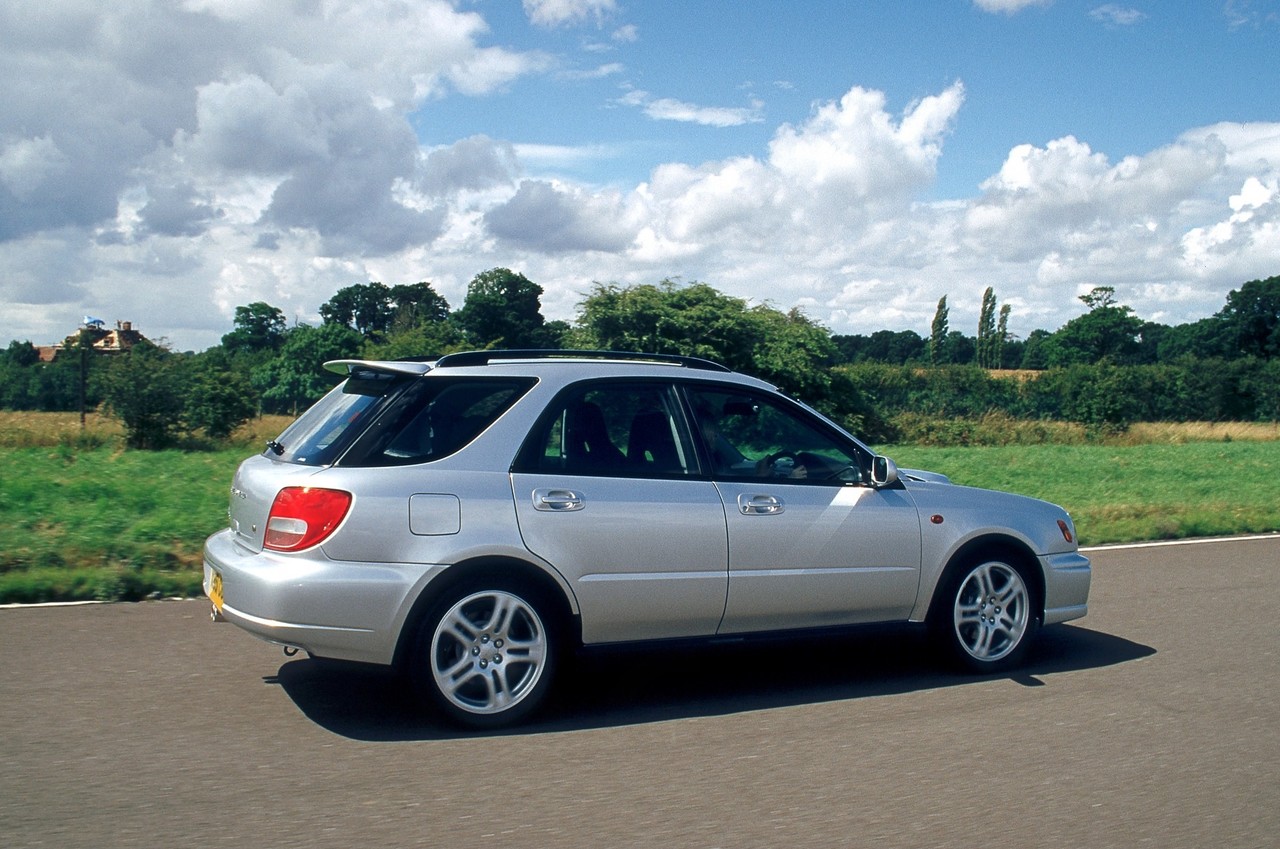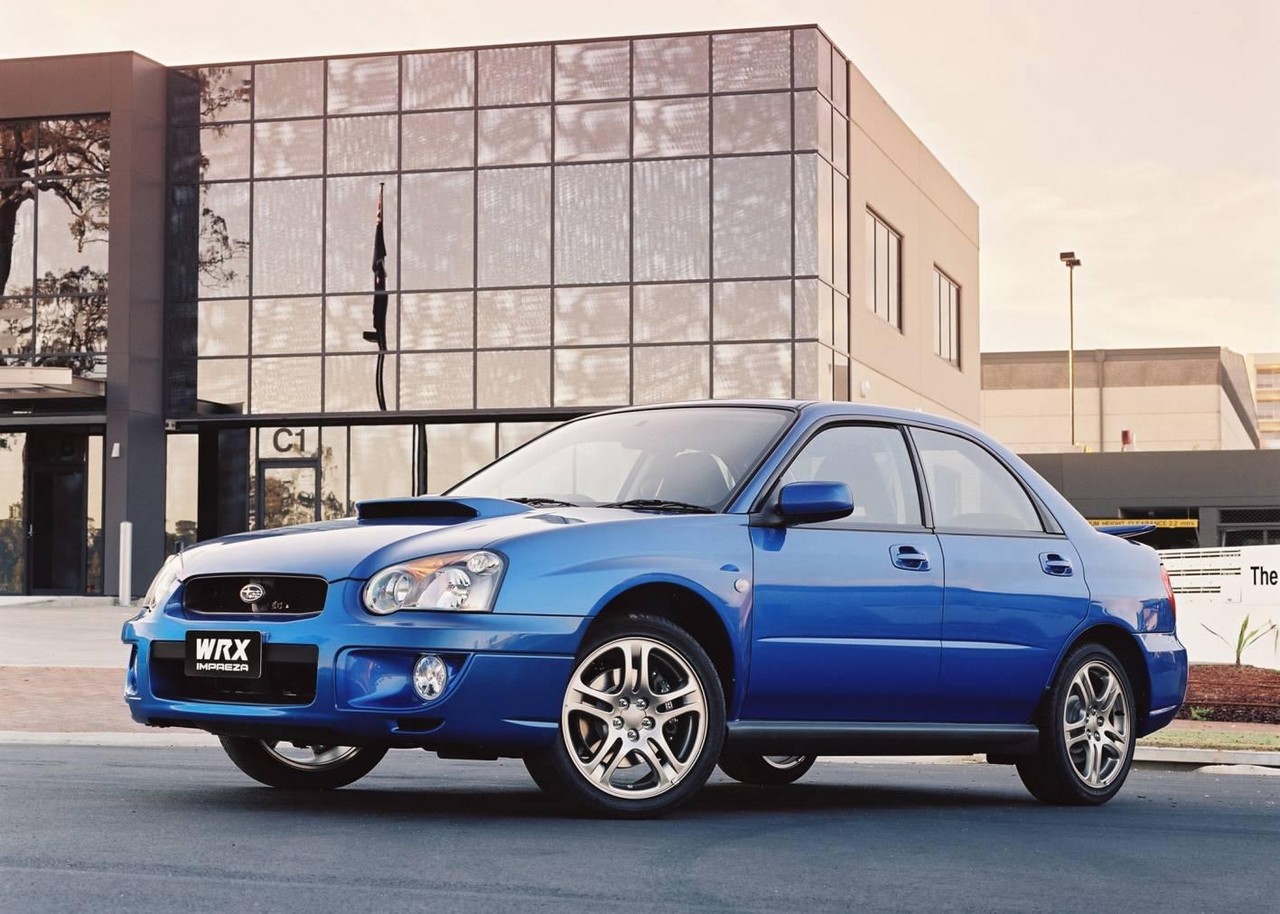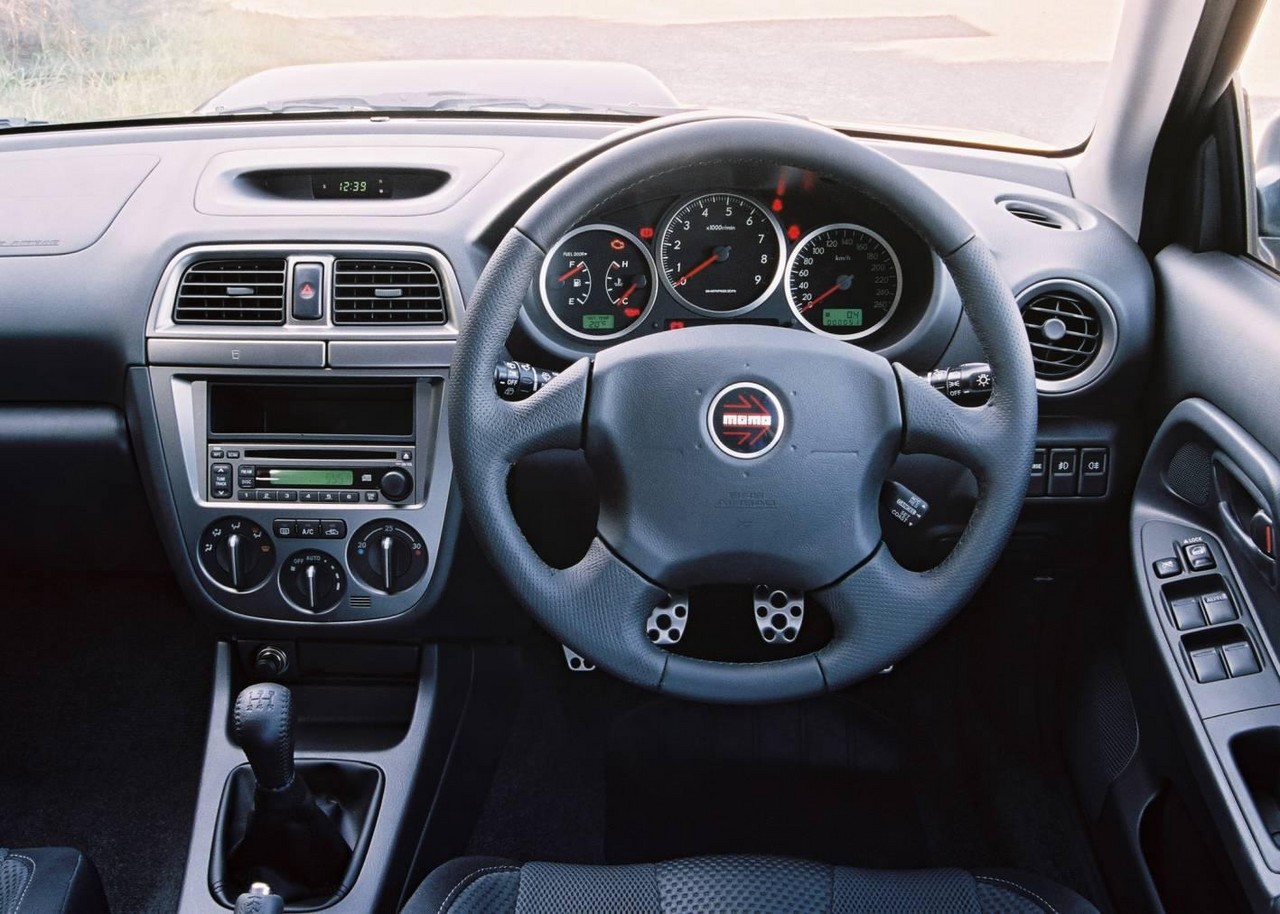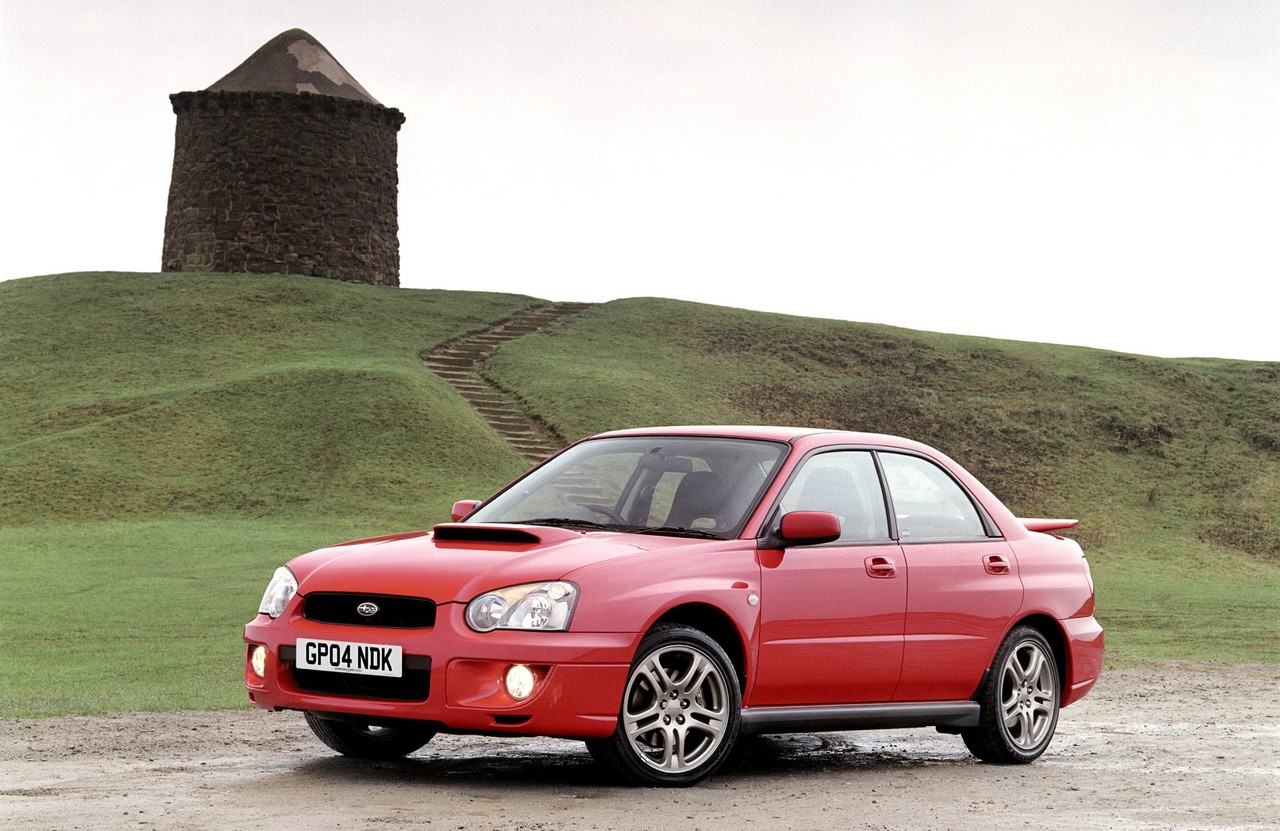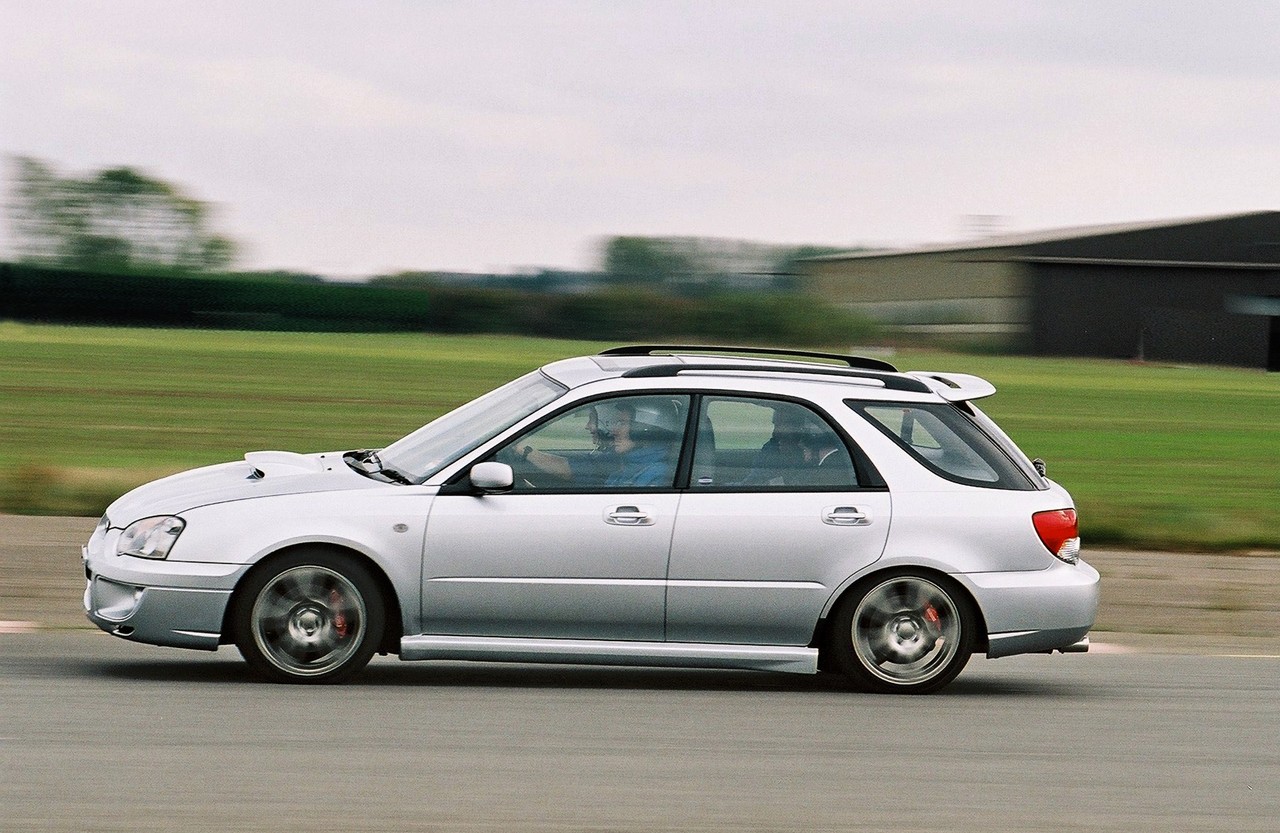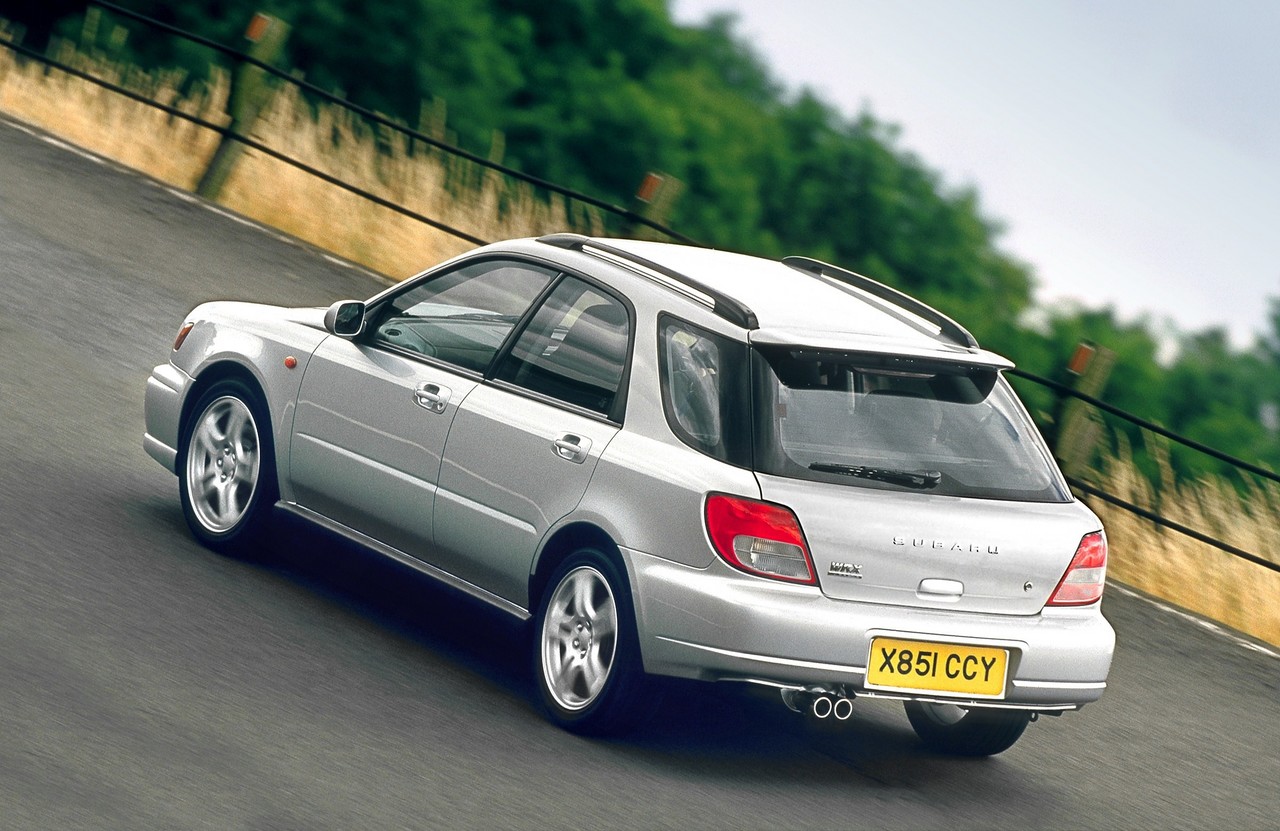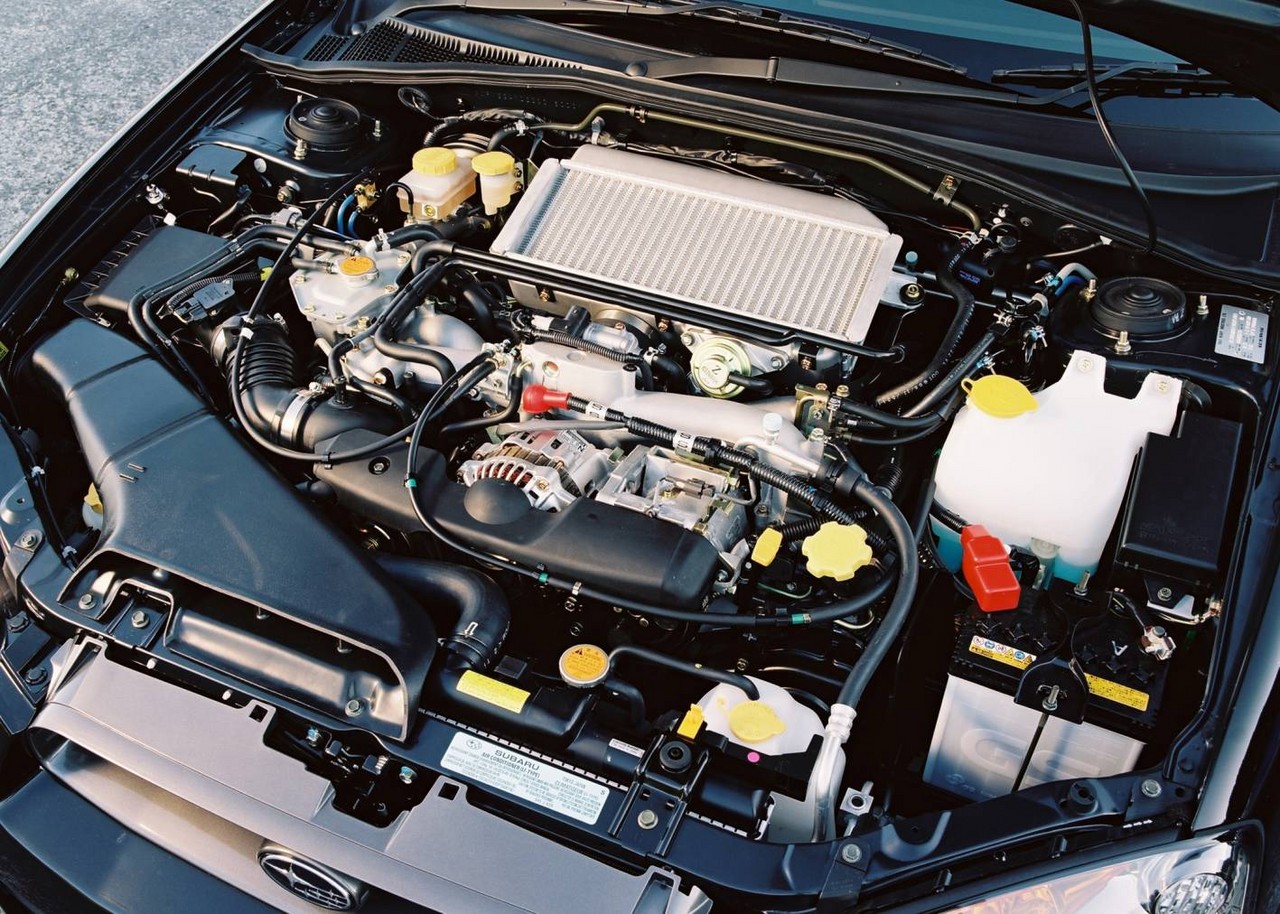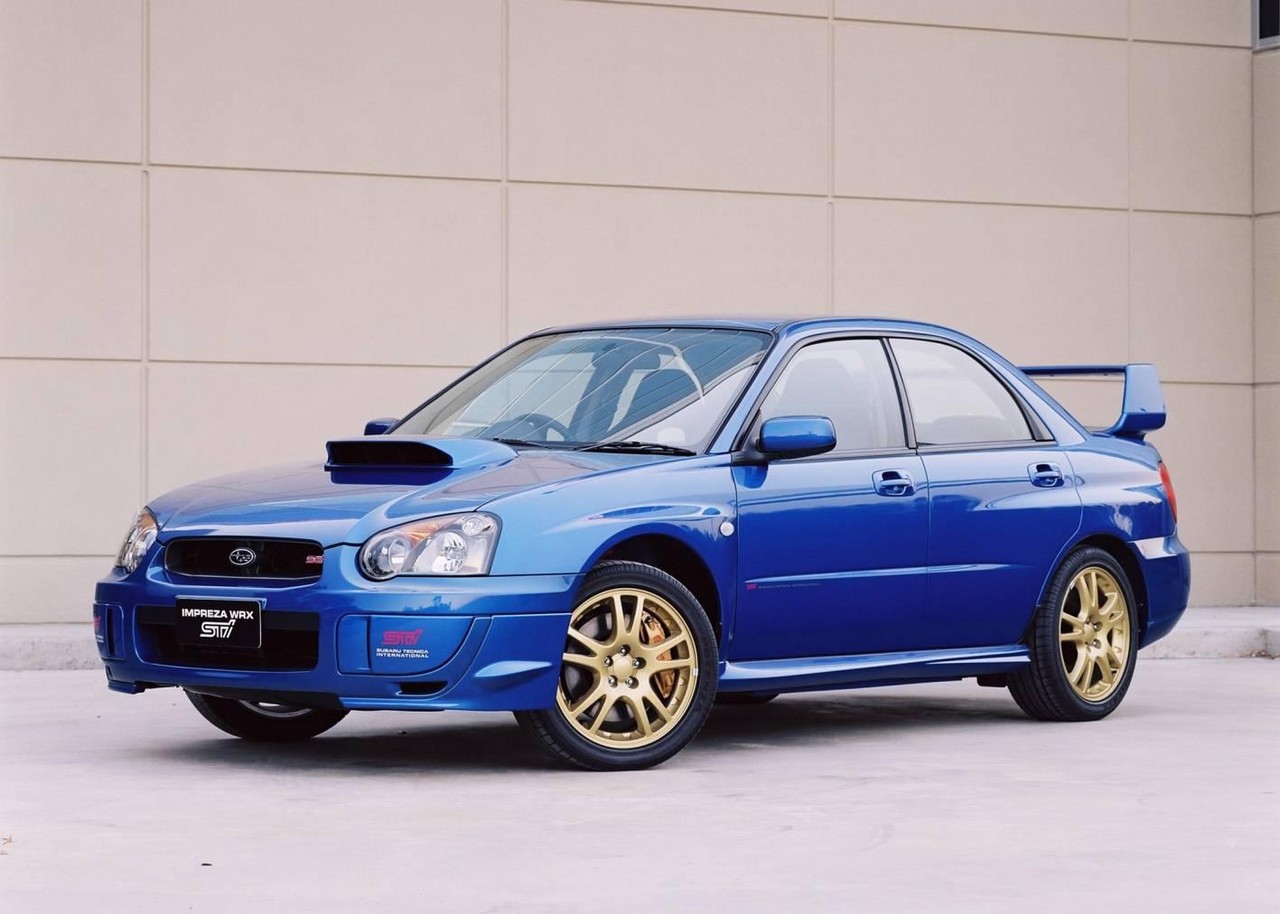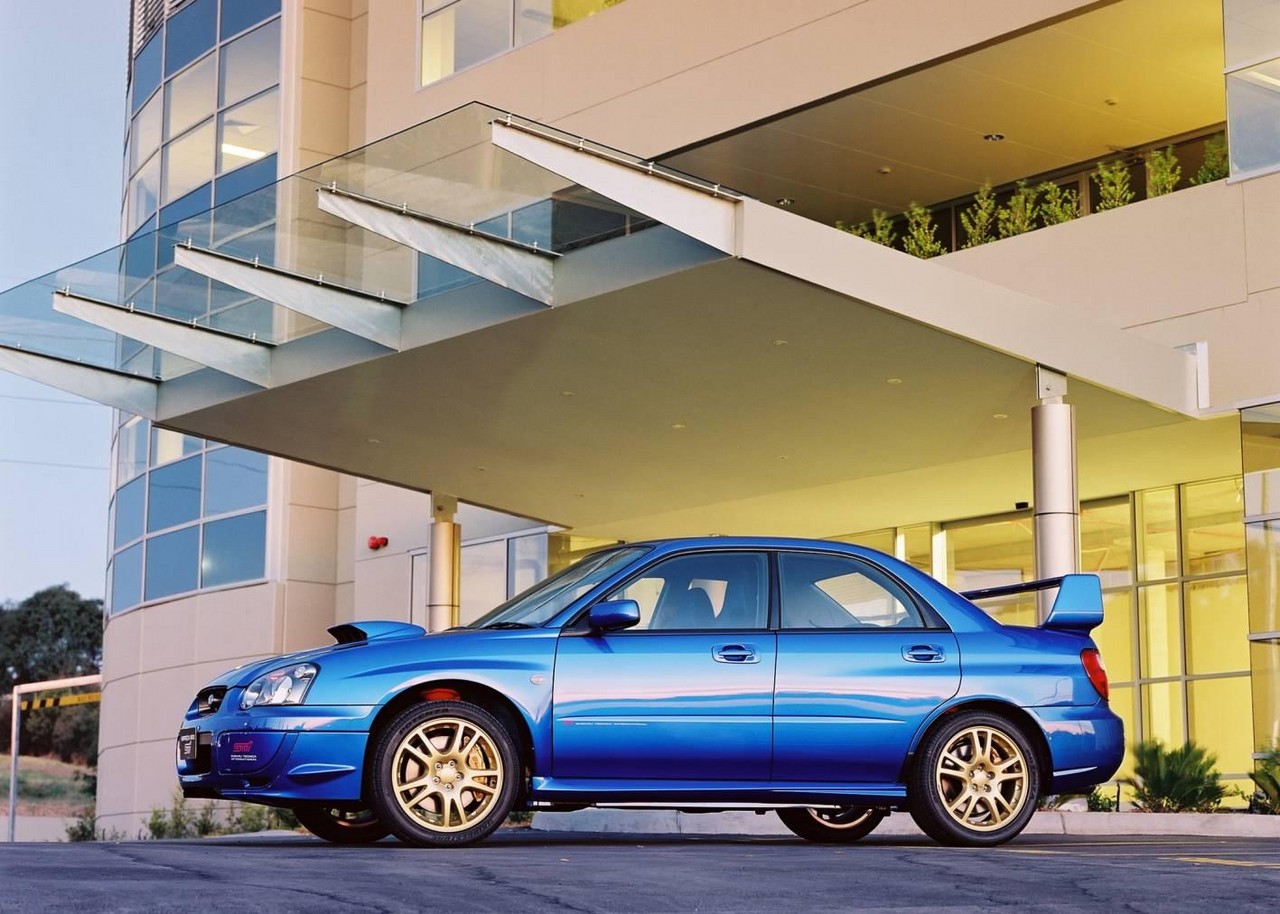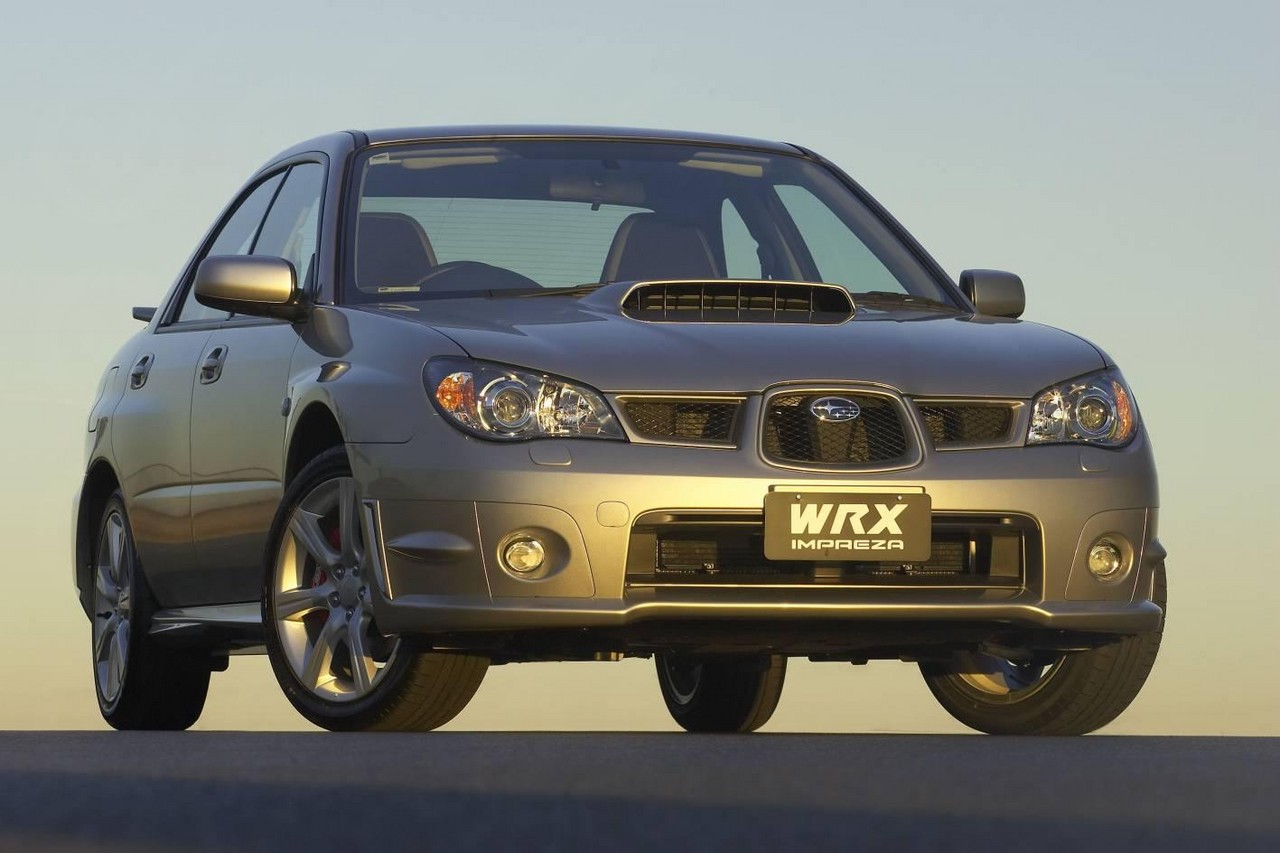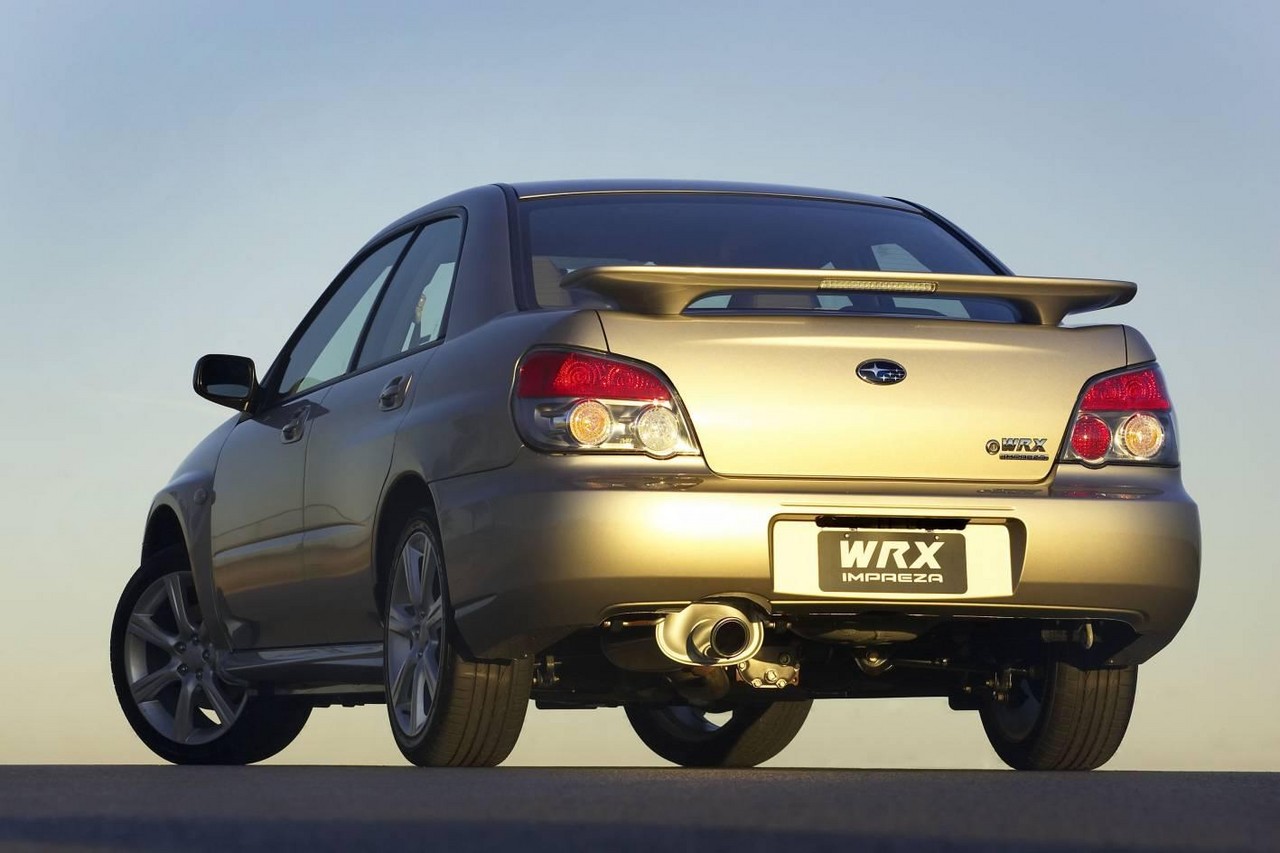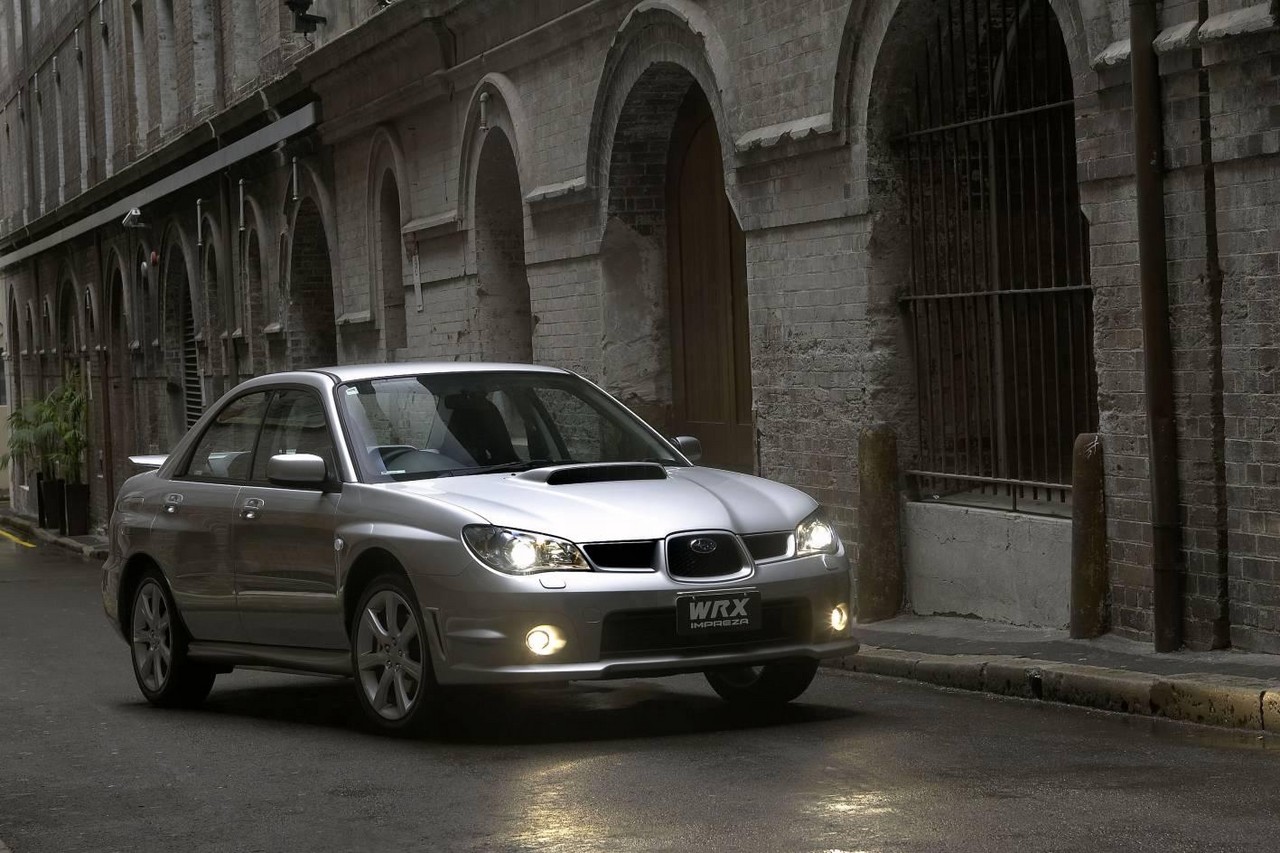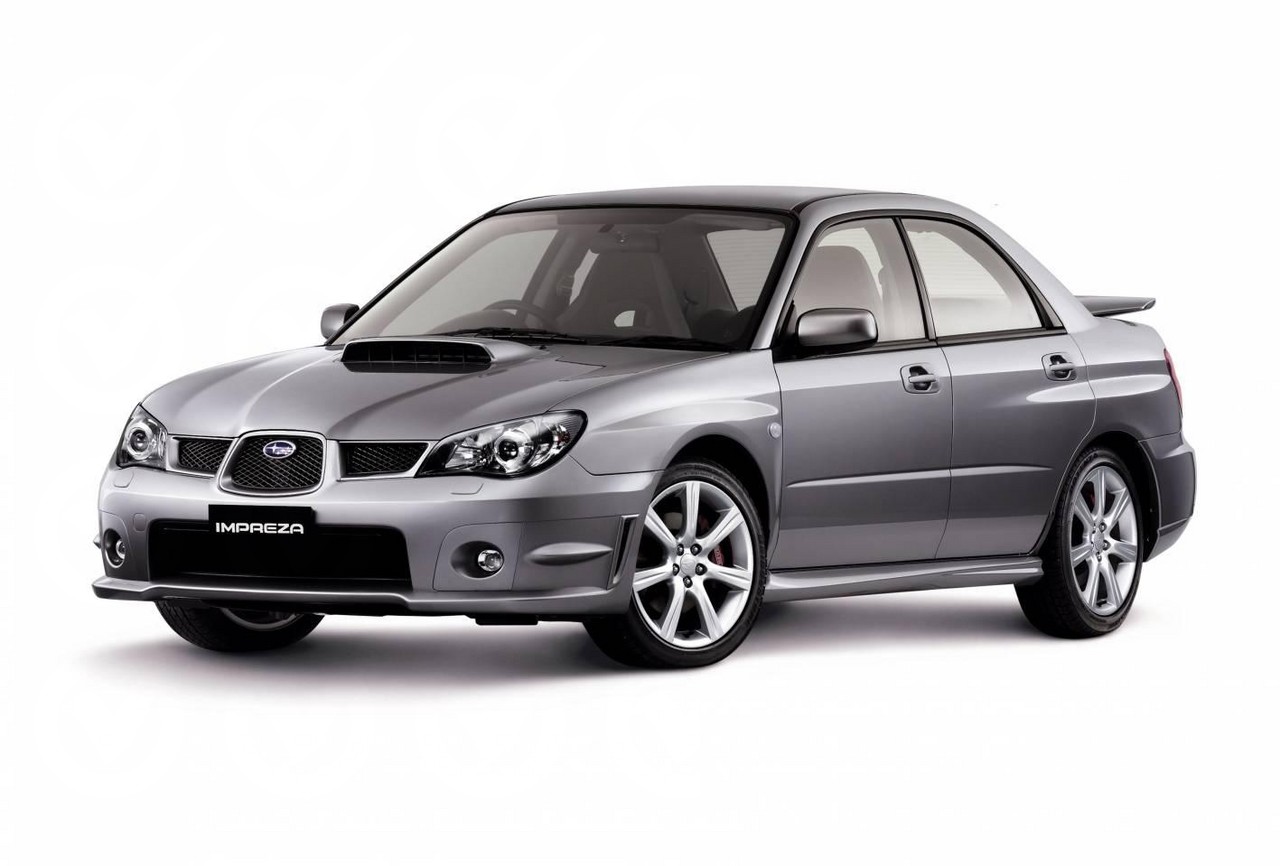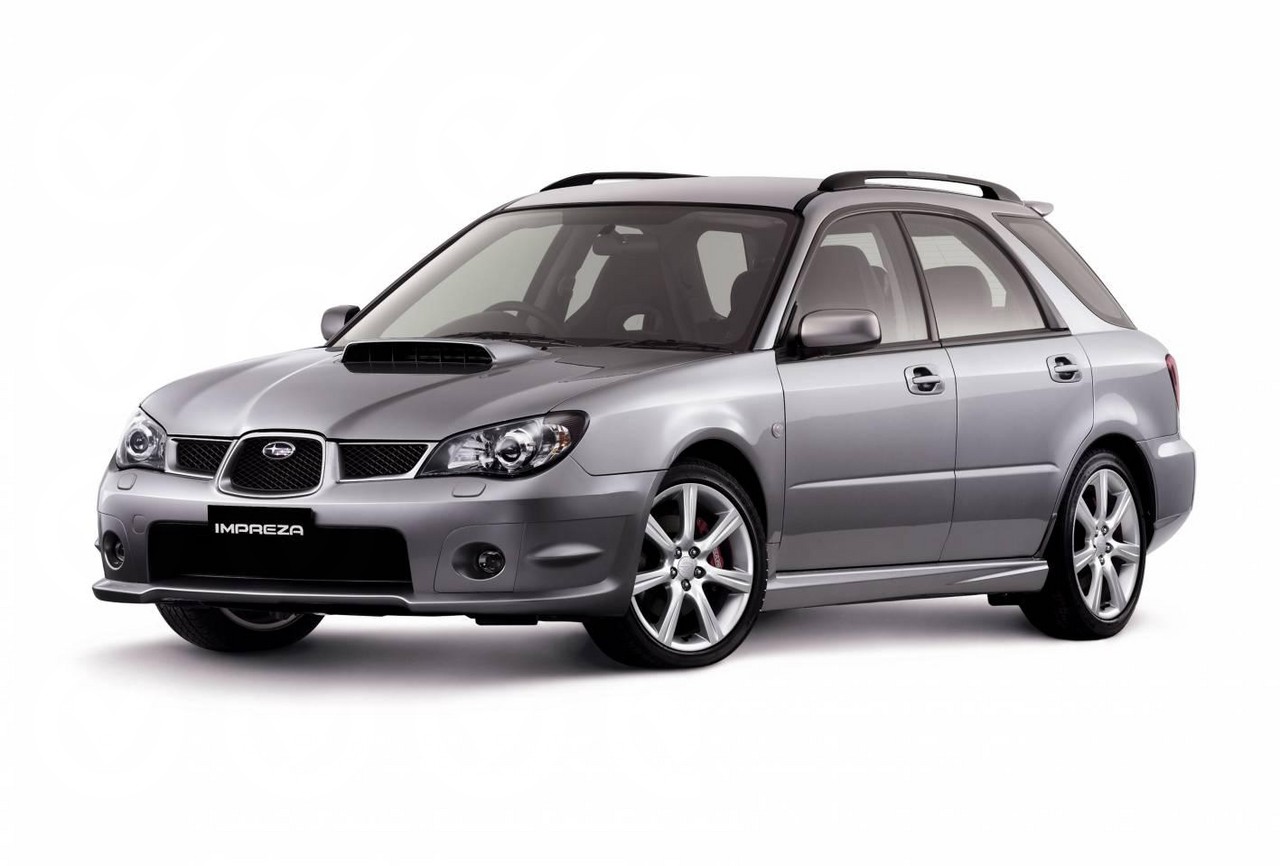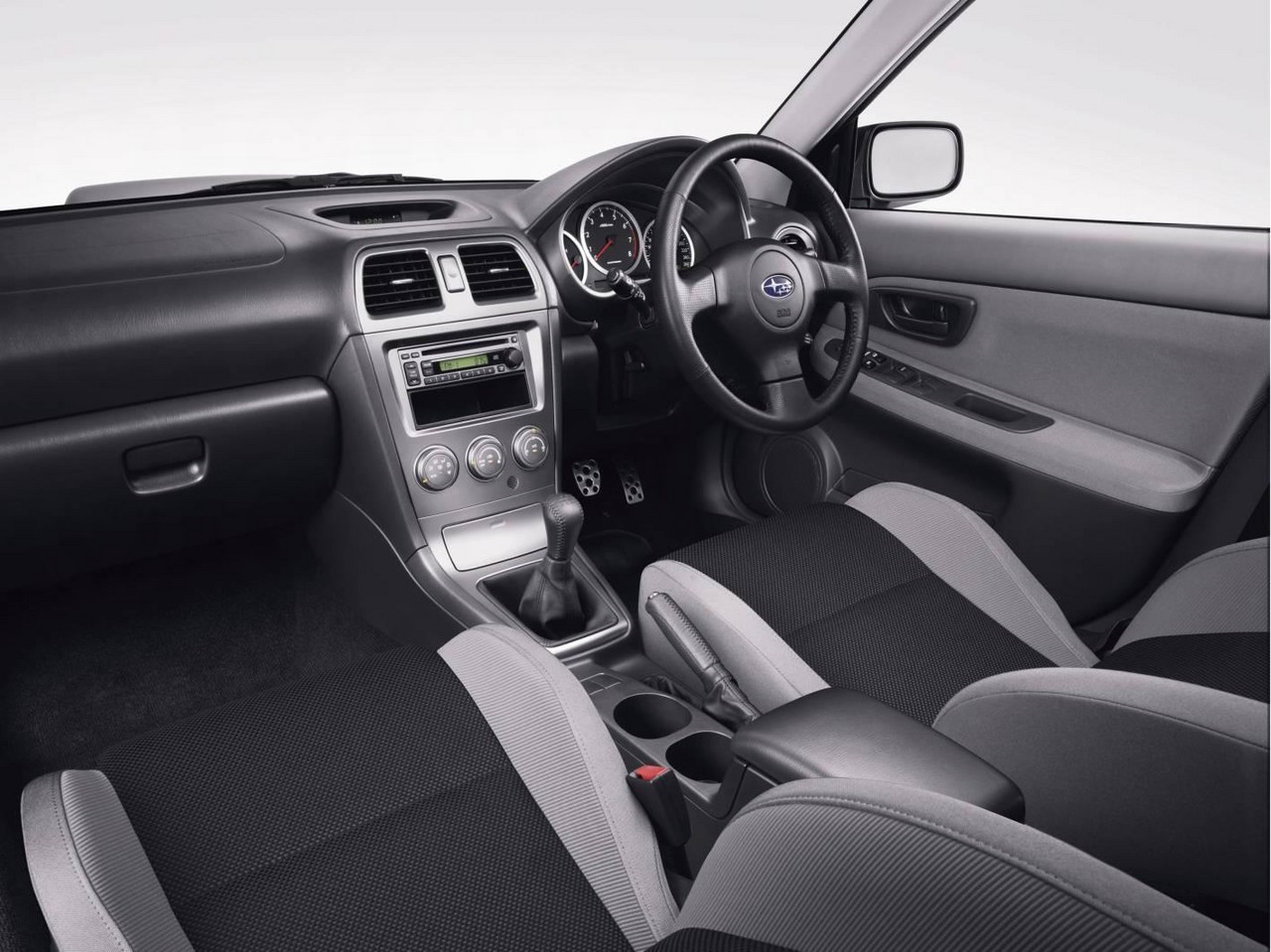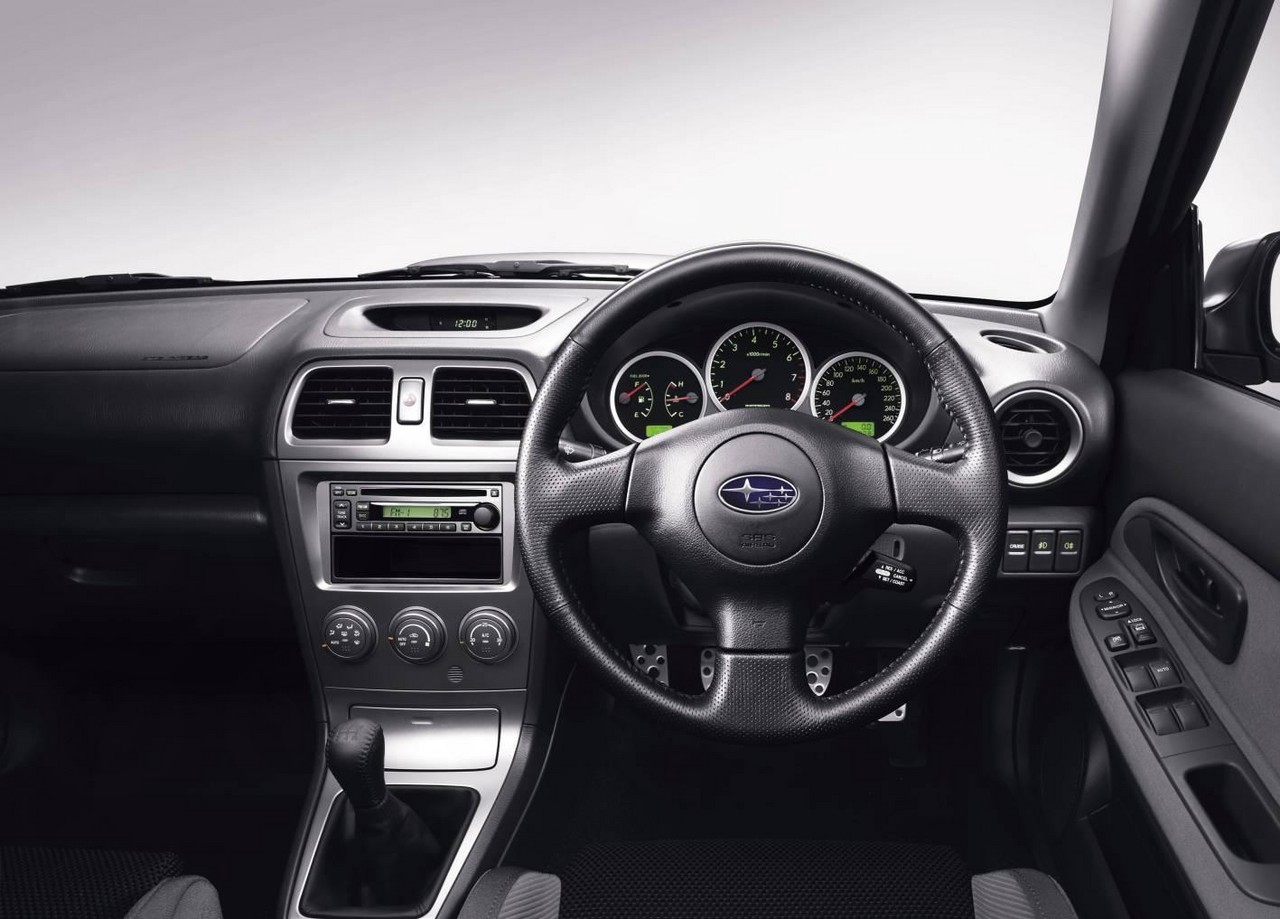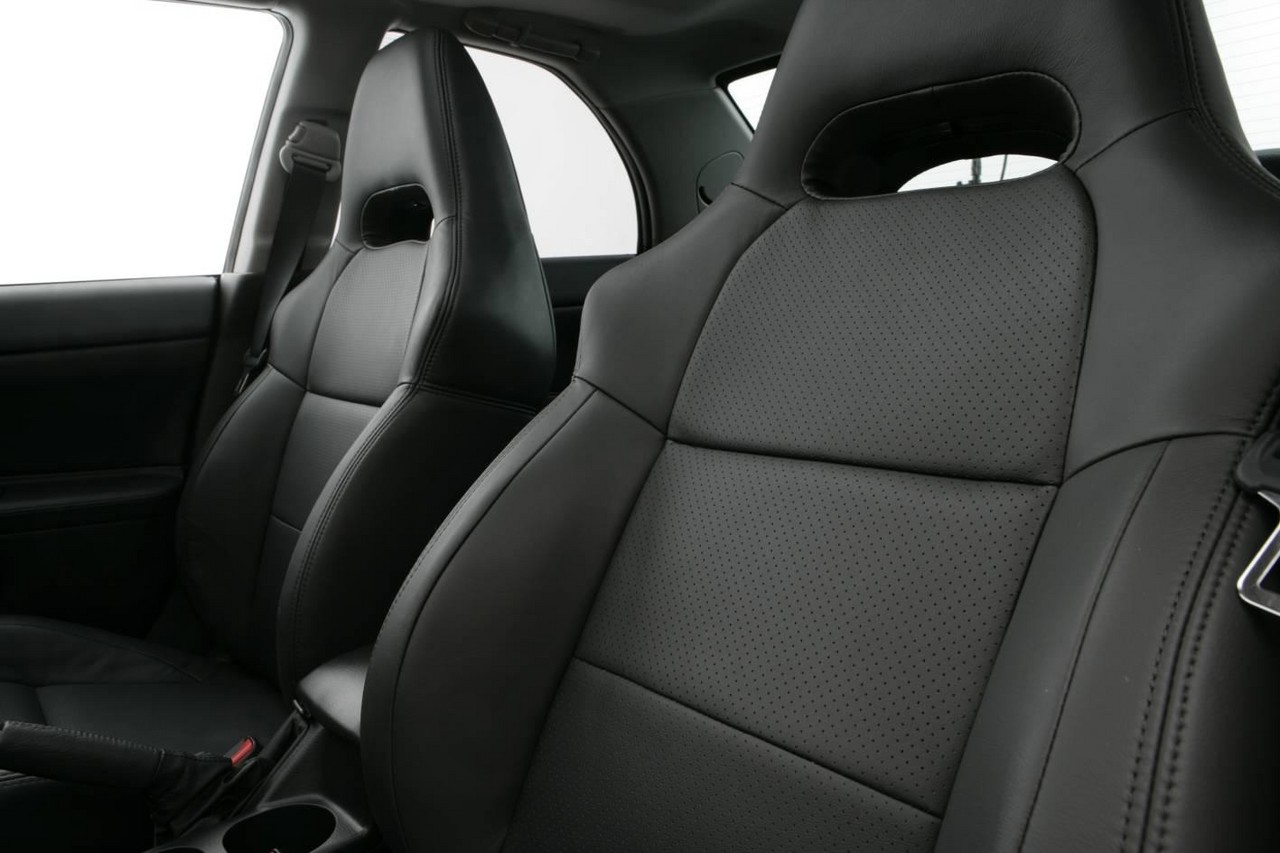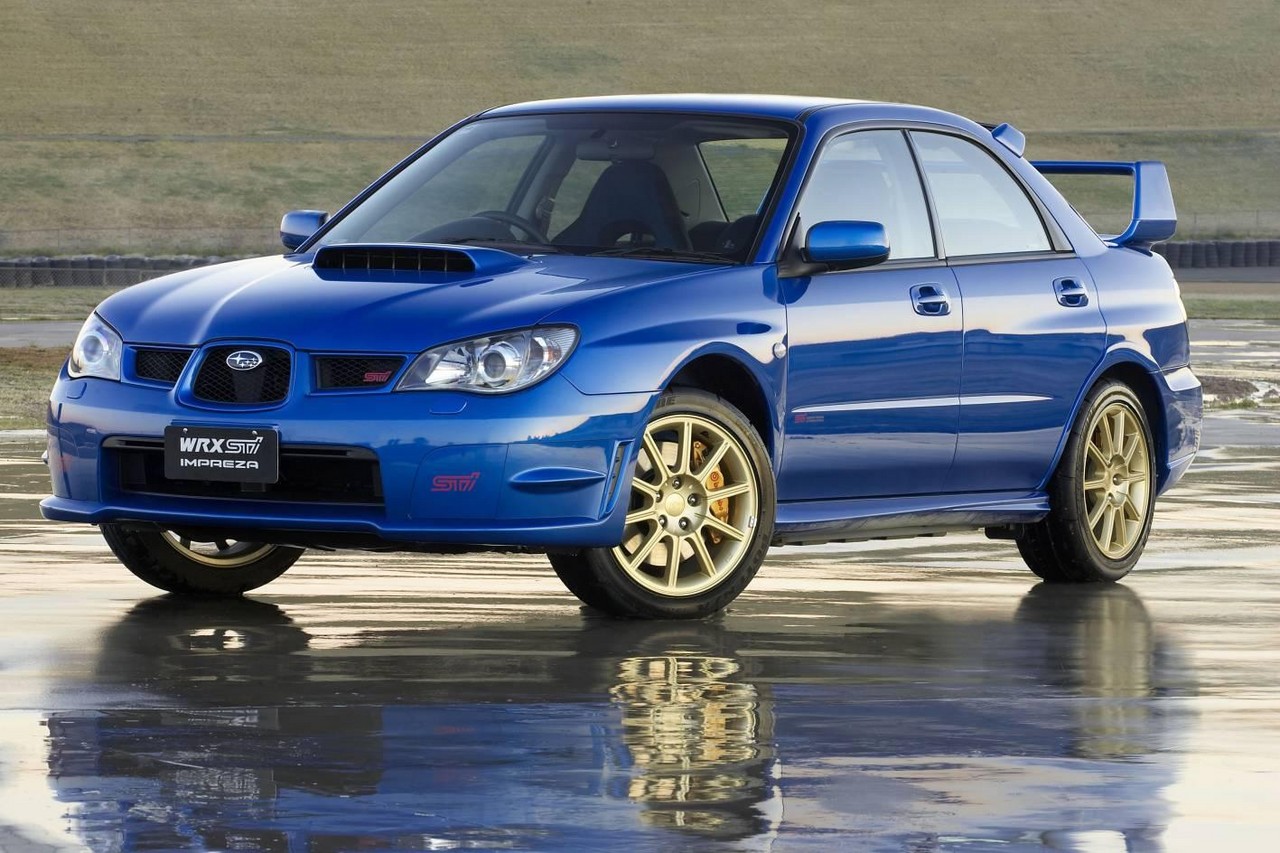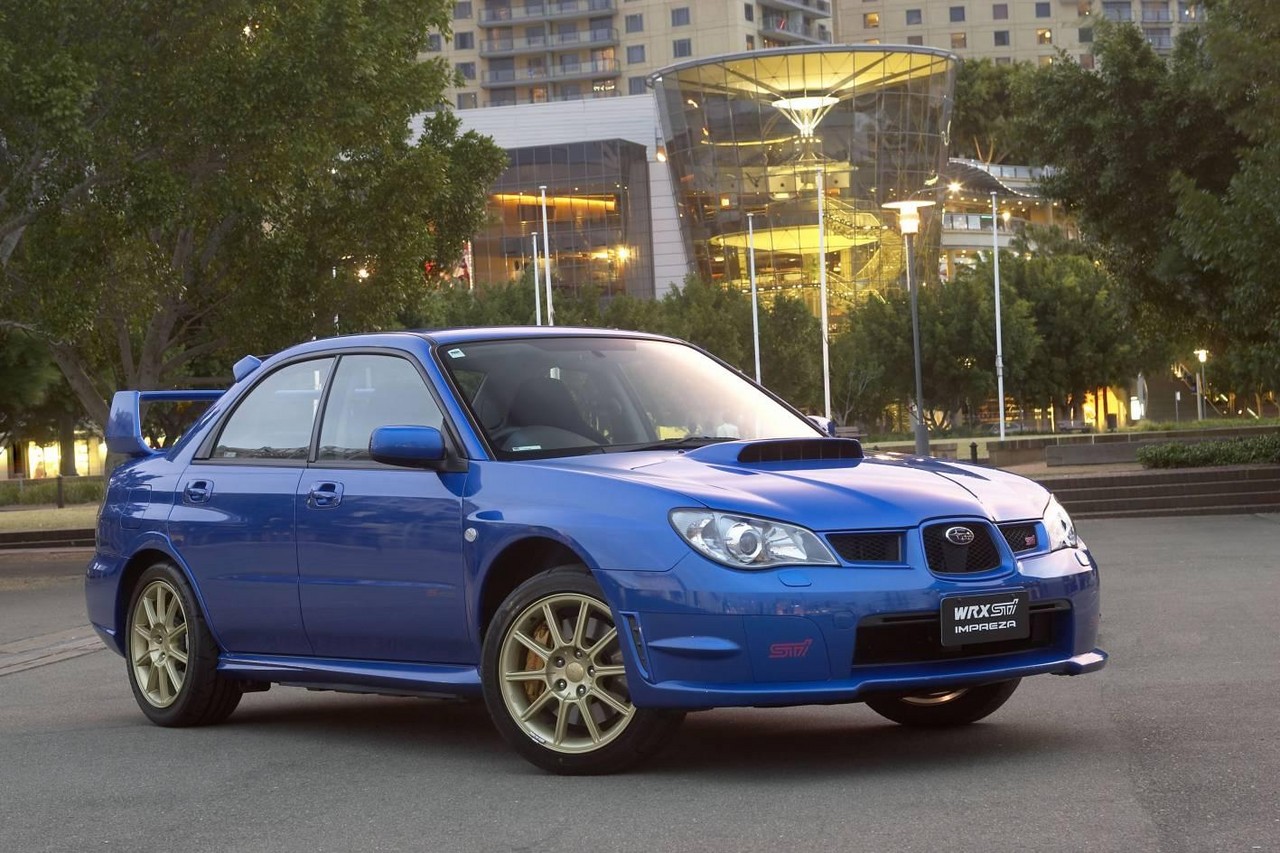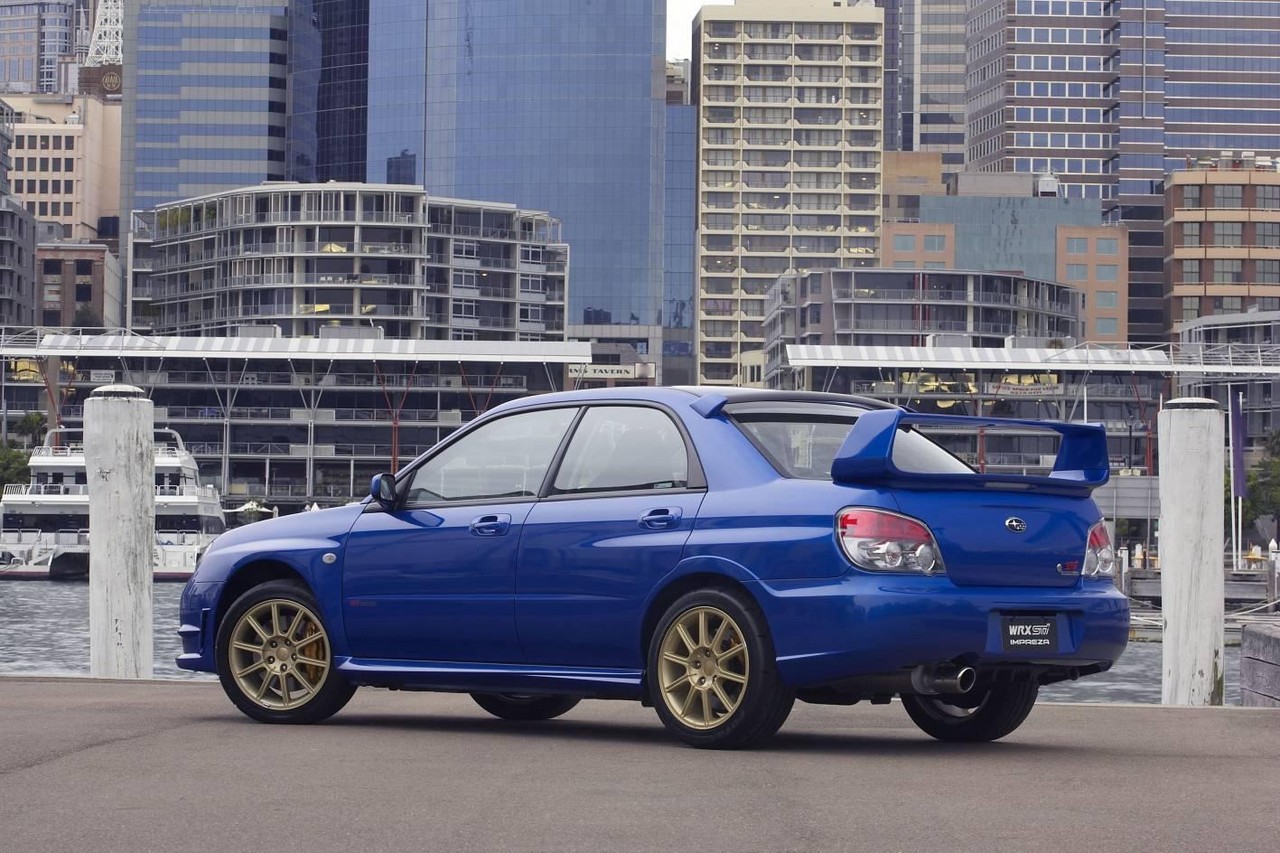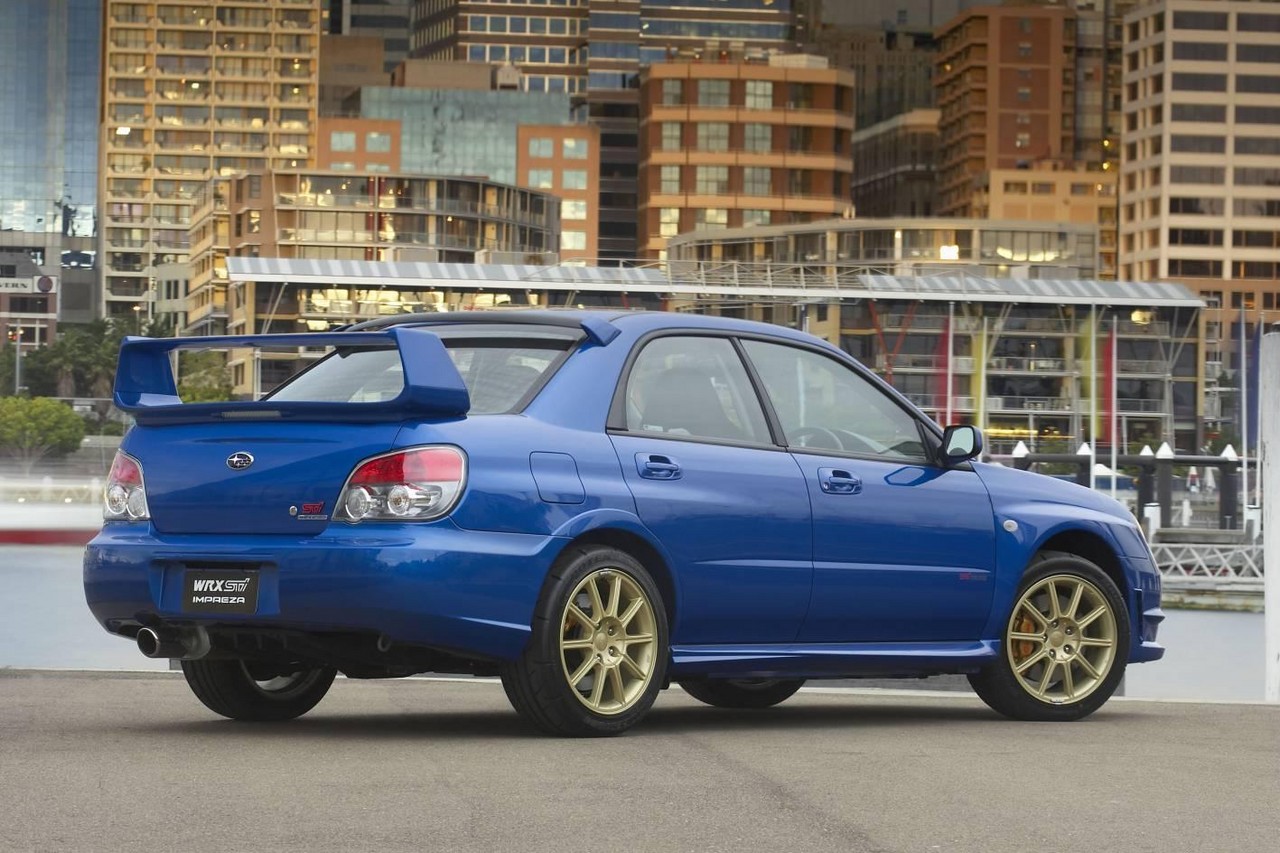
- Powerful 2.0- and 2.5-litre turbo petrol engines
- All-wheel drive traction (via two different systems) makes for impressive dynamics
- For Impreza WRX, surprisingly compliant ride
- Supportive front seats
- Significantly stronger – but heavier – body than the Subaru GC/GM Impreza WRX
- Light steering lacks feel
- Narrower track of Impreza WRX hatch reduces stability
- For Impreza WRX with 2.0-litre turbo engine, poor performance below 3000 rpm
- For Impreza WRX STi with 2.0-litre turbo engine, poor performance below 4000 rpm
- Rear seat doesn’t fold
Review: Subaru GD.I/GG.I Impreza WRX (2000-02)
Overview
Released in October 2000, the Subaru GD and GG Series I (GD.I and GG.I) Impreza WRX was available as a sedan or wagon, respectively. Manufactured in Ota, Japan, the GD/GG Impreza WRX range was initially powered by Subaru’s 2.0-litre horizontally opposed four-cylinder EJ205 engine which was mated to a five-speed manual transmission.
In October 2001, an automatic transmission was introduced for the Impreza WRX and the Impreza WRX STi was released. As part of the October 2001 update, the standard Impreza WRX was fitted with stiffer front suspension, strengthened pillars, side sills and doors, upgraded brakes, a window-integrated radio aerial and a temperature display within the instrument cluster.
WRX: EJ205 engine
For the GD/GG Impreza WRX, the EJ205 engine had an open-deck die-cast aluminium block with cast iron liners, a die-cast aluminium cylinder head, a Mitsubishi TD04L turbocharger which provided peak boost pressure of 93 kPa (13.5 psi), an air-cooled intercooler, double overhead camshafts per cylinder bank (belt-driven), four valves per cylinder, Tumble Generator Valves (TGVs) and a compression ratio of 8.0:1.
WRX STi: EJ207 engine
For the GD Impreza WRX STi, the 2.0-litre EJ207 engine had a semi-closed aluminium block, an aluminium cylinder head, double overhead camshafts (belt-driven), four valves per cylinder, variable intake valve timing (Subaru’s ‘Active Valve Control Ssystem’ or AVCS), forged aluminium alloy pistons and a compression ratio of 8.0:1. Furthermore, the GD Impreza WRX STi had an IHI VF35 RHF55 turbocharger which provided maximum boost pressure of 113 kPa (16.4 psi).
Dimensions and suspension
Compared to the GC Impreza WRX , the GD Impreza WRX sedan was 55 mm longer (at 4405 mm), 40 mm wider (1730 mm), 40 mm taller (1440 mm) and had a 5 mm longer wheelbase (2525 mm). Relative to the GD sedan, however, the GG Impreza WRX wagon was 35 mm narrower (at 1695 mm) and 25 mm taller (1465 mm). The GD/GG Impreza WRX had MacPherson strut front suspension and independent rear suspension with dual lateral links.
| Body | Engine | Trans. | Years | Peak power | Peak torque | |
|---|---|---|---|---|---|---|
| WRX | Sedan, wagon | 2.0-litre EJ205 turbo petrol F4 | 5sp man. | 2000-02 | 160 kW at 5600 rpm | 292 Nm at 3600 rpm |
| 4sp auto | 2001-02 | |||||
| WRX STi | Sedan | 2.0-litre EJ207 turbo petrol F4 | 6sp man | 2001-02 | 195 kW at 6000 rpm | 343 Nm at 4000 rpm |
AWD systems
For Impreza WRX models with manual transmissions, the all-wheel drive system which utilised a viscous coupling locking differential. In normal conditions, the system provided a 50:50 front:rear torque split. In the event that traction was lost, however, up to 80 per cent of the engine’s torque could be directed to either the front or rear axles.
For Impreza WRX models with automatic transmissions, there was an electronically-controlled hydraulic transfer clutch and a planetary gear centre differential. In normal conditions, the system provided a 45:55 front:rear torque split. However, the variable torque distribution (VTD) system constantly measured front and rear driveshaft speeds, throttle position and gear selection and used these inputs to vary the front/rear torque split for optimum traction.
Safety equipment
Standard safety equipment for the Subaru GD/GG Impreza WRX included dual front airbags, ABS and front seatbelts with pretensioners and load limiters.
Features: Impreza WRX
Standard features for the Subaru GD/GG Impreza WRX included 17-inch five-spoke alloy wheels with 215/45 R17 tyres, a six speaker sound system with six-stack CD player, semi-automatic air conditioning, cruise control, a leather-wrapped Momo steering wheel, aluminium pedals, remote central locking, power mirrors and windows, a height adjustable driver’s seat, tilt adjustable steering wheel, UV-protecting glass, dual trip meters, an alarm and immobiliser.
Features: Impreza WRX STi
Compared to the standard Impreza WRX, the GD Impreza WRX STi was distinguished by its 17-inch five-spoke gold-finish alloy wheels with 225/45 R17 Bridgestone Potenza RE040 tyres, WRC-spec headlights, unique grille, front fog light aperture covers, taller bonnet scoop and large diameter STi exhaust tip.
2002 Impreza WRX Club Spec Evo 5
In February 2002, the Impreza WRX Club Spec Evo 5 was released. Compared to the standard WRX, the Club Spec Evo 5 was fitted with a six-disc CD player, power sunroof and individually number badge on the centre console.
Review: Subaru GD.II/GG.II Impreza WRX (2002-05)
Overview
Released in December 2002, the Subaru GD and GG Series II (GD.II and GG.II) Impreza WRX introduced mechanical upgrades and updated styling. The Impreza WRX engine was fitted with variable valve timing (Subaru’s ‘Active Valve Control System’) and had a higher compression ratio (increased from 8.0:1 to 9.0:1), while automatic models were fitted with the ‘Sportshift’ gear-lever for sequential shifting. Steering manoeuvrability and stability were improved through the introduction of dampers with multiple phase valves, changes to upper suspension mountings and the relocation of rear trailing links.
Visually, the ‘bug eyes’ of the GD.I/GG.I Impreza WRX were replaced with a redesigned bonnet, headlights and bumpers. Inside, the Impreza WRX had a more prominent centre tachometer in the instrument binnacle and a chrome hand-brake button; the WRX STi was fitted with a smaller three-spoke sports steering wheel and a new instrument binnacle with red back-lighting.
| Body | Engine | Trans. | Peak power | Peak torque | |
|---|---|---|---|---|---|
| WRX | Sedan, wagon | 2.0-litre EJ205 turbo petrol F4 | 4sp auto, 5sp man. |
168 kW at 6000 rpm | 300 Nm at 3600 rpm |
| WRX STi | Sedan | 2.0-litre EJ207 turbo petrol F4 | 6sp man. | 195 kW at 6000 rpm | 343 Nm at 4000 rpm |
Features
Compared to its GD.I/GG.I predecessor, standard features were largely unchanged, although all models were fitted with a keypad immobiliser alarm system as standard. Combined with DataDot technology, vehicle security was significantly improved.
August 2004 update: Impreza WRX STi with DCCD
In August 2004, the Impreza WRX STi was updated – changed included wider 17 x 8-inch wheels with 225/45 Bridgestone Potenza tyres, a front helical limited slip differential and a Driver Controlled Centre Differential (‘DCCD’) with automatic and manual modes. In manual mode, the DCCD could be adjusted from a fixed 50:50 front/rear torque split to 35:65. In automatic mode, input from a yaw rate sensor was used to determine the optimum front/rear torque split. Other changes included a aluminium front and rear suspension links, increased diameter sway bars (front and rear), 10 mm wider rear track, 15 mm longer wheelbase due to a revised rear suspension mount and the addition of damper valves to reduce steering column kickback.
Impreza WRX Club Spec Evo 6, 7 and 8
During its production, limited-run Club Spec Evo 6, 7 and 8 editions were released in April 2003, January 2004 and March 2005, respectively. Compared to the standard WRX, the Club Spec variants were fitted with front seat-mounted side airbags, leather trimmed seats and a factory-fitted sunroof.
2004 Impreza WRX Petter Solberg Limited Edition
In February 2004, a Petter Solberg Limited Edition WRX was released. Compared to the standard WRX, the Petter Solberg Limited Edition added a silver sports gearshift knob, ‘Petter Solberg WRC’ console badge and key ring and was finished in ‘WR Blue’ paint.
2005 Impreza WRX WRP10
In January 2005, a limited-run WRP10 variant of the Impreza WRX was released. Compared to the standard Impreza WRX, the WRP10 was fitted with 17-inch five-spoke RAYS alloy wheels with Pirelli P Zero Nero tyres (215/45 R17 91Y), 15 mm lower suspension and a carbon fibre strut brace. The WRP10 also benefited from an STI engine performance upgrade kit which increased peak power to 175 kW at 6000 rpm by replacing the electronic control unit (ECU), fitting an upgraded exhaust and a large single tip muffler.
Review: Subaru GD.III/GG.III Impreza WRX (2005-07)
Overview
Released in August 2005, the GD/GG Series III Impreza WRX range introduced Subaru’s 2.5-litre EJ255 and EJ257 turbocharged four-cylinder engines for the WRX and WRX STi, respectively.
For the Impreza WRX STi, the all-wheel drive system was modified as the Driver Controlled Centre Differential (DCCD) was fitted with dual mechanical and electronically-controlled limited slip differential; the static torque distribution ratio was also changed from 35:65 to 41:59. Furthermore, the six-speed manual transmission was also upgraded for smoother gearshifts.
Visually, the GD/GG Series III Impreza WRX could be identified by its three-piece grille and more aerodynamically efficient bonnet scoops.
EJ255 and EJ257 engines
For the Impreza WRX, the turbocharged 2.5-litre EJ255 engine had a semi-closed die-cast aluminium block with cast iron liners, an aluminium cylinder head with cross-flow cooling, double overhead camshafts per cylinder bank (belt-driven), four valves per cylinder, variable intake valve timing (Subaru’s ‘Active Valve Control System’ or AVCS), Tumble Generator Valves (TGVs) and a compression ratio of 9.0:1. For the GD/GG Impreza WRX, the EJ255 engine had a Mitsubishi TD04L turbocharger which provided peak boost pressure of 93 kPa (13.5 psi).
For the Impreza WRX STi, the EJ257 engine had similar properties but differed in that it had an IHI VF48 RHF55 turbocharger which provided peak boost pressure of 103 kPa (14.9 psi); also, its compression ratio was 8.0:1.
| Variant | Body | Engine | Trans. | Peak power | Peak torque |
|---|---|---|---|---|---|
| WRX | Sedan, wagon | 2.5-litre EJ255 turbo petrol F4 | 5sp man. | 169 kW at 5600 rpm | 320 Nm at 3600 rpm |
| WRX STi | Sedan | 2.5-litre EJ257 turbo petrol F4 | 6sp man. | 206 kW at 5600 rpm | 392 Nm at 4000 rpm |
Safety equipment
Standard safety equipment improved with all Impreza WRX models – but not the Impreza WRX STi – fitted with front seat-mounted side airbags. The front seat cushions were also redesigned to minimise submarining in the event of a collision.
Features
As part of the update, the Impreza WRX was fitted with 17-inch seven-spoke alloys, while both the WRX and WRX STi were fitted with self-levelling high intensity discharge (HID) headlights with pop-out jet washers.
2006 Impreza WRX Tuned by STi
In January 2006, a limited-run ‘Tuned by STi’ edition of the Impreza WRX was released. Compared to the standard Impreza WRX, the Tuned by STi edition was fitted with 18-inch STi Enkei alloy wheels with wider Pirelli P-Zero Nero tyres, leather trim, an aluminium gear knob, short shift gear linkage, a power sunroof and STi front lip spoiler. A tuned ECU and low back-pressure exhaust muffler also improved performance, with peak power and torque outputs of 179 kW at 5600 rpm and 340 Nm at 3200 rpm.
2006 Impreza WRX Club Spec Evo 9
In August 2006, the WRX Club Spec Evo 9 was released. Compared to the standard WRX, the Club Spec Evo 9 was fitted with 18-inch alloy wheels with STi suspension kit, leather trim, a short-shift gear lever, power sunroof and STi front lip spoiler.
Related links
